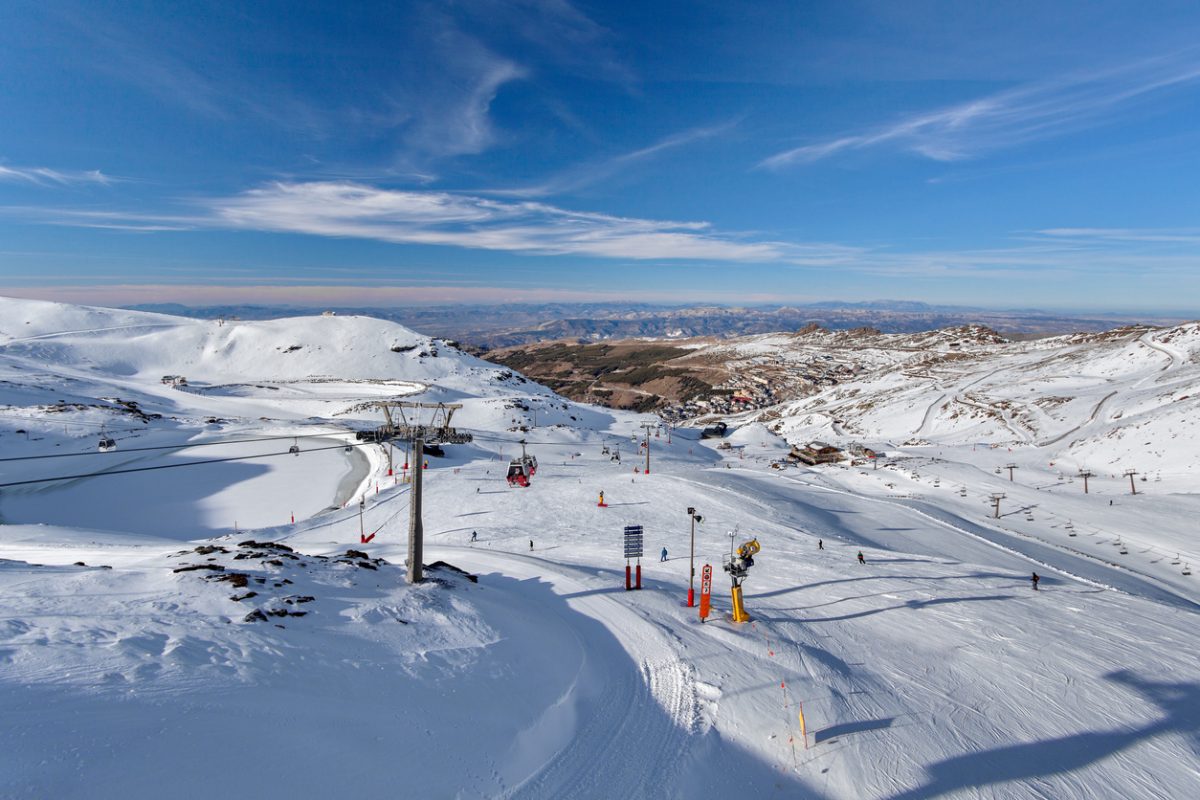Do you have questions about where to go skiing in Europe, when is peak ski season and what’s the best ski resort in Europe for different types of trips?
Look no further – I’m answering all of your questions in this post!
As winter descends in Europe, snow begins to fall on its peaks, quickly covering ski resorts all over the continent.
Snowsports enthusiasts dust off their gear, and families start to book trips to Europe’s most renowned ski resorts.
Whether you’re after apres-ski in the Alps, family-friendly skiing in Bulgaria’s Rila mountains or a snowy trip to the Spanish Pyrenees, there are pockets of mountains all over Europe that welcome skiiers and snowboarders (and anyone who likes the snow!) alike.
This blog post will answer all of your questions about skiing in Europe. Where to go on a budget? Where’s best for nightlife? Which resorts are the most family-friendly?
Read on, as we detail the best ski resorts in Europe and answer all of your FAQs!
When to go skiing in Europe
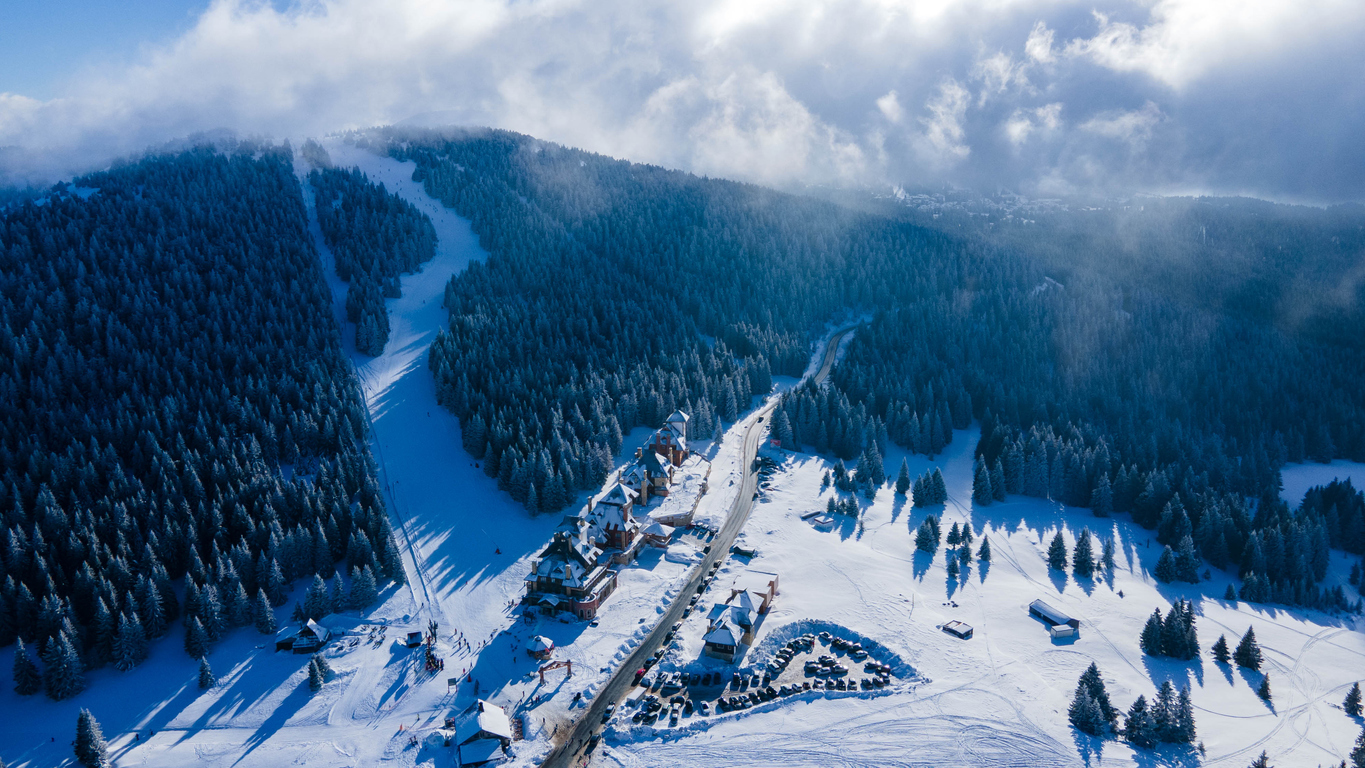
Skiing in Europe offers a wide range of experiences, varying from country to country and even from one resort to another.
Here’s a month-by-month guide to help you decide the best time to hit the slopes.
Skiing in Europe in November
November marks the beginning of the ski season in many European destinations, especially in higher-altitude areas like the Alps.
Some resorts open with the first snowfall, while others rely on snow-making machines.
If you’re looking to avoid crowds and enjoy lower prices, this can be an ideal time.
Skiing in Europe in December
December offers more consistent snow conditions, especially towards Christmas and New Year’s holidays.
It’s a festive time to ski, with many resorts decorating and hosting special events.
Keep in mind that popular resorts may get crowded, and prices can be higher during this peak season.
Skiing in Europe in January
January often brings cold temperatures and excellent snow conditions.
With the holiday crowds gone, you’ll find fewer people on the slopes and slightly lower prices.
If you love fresh powder and more challenging skiing, January might be your perfect month.
Skiing in Europe in February
February continues to provide good snow conditions.
Many families take advantage of the school holidays to go skiing, so some resorts can be busier.
Booking in advance and considering lesser-known destinations can be a good strategy for this month.
Skiing in Europe in March
March is known for longer daylight hours, milder temperatures, and still offering reliable snow conditions in many areas.
It’s a great month for those who prefer more comfortable weather and want to enjoy après-ski activities.
Skiing in Europe in April
April is the tail end of the ski season in most of Europe.
While lower-altitude resorts might struggle with snow quality, higher-altitude locations can still provide good skiing.
You’ll find more spring-like conditions, and many resorts host end-of-season parties and events.
Where to go skiing in Europe
There are so many places to ski in Europe.
Here are just a few places that are excellent for skiing. I’ve included a brief description of the ski scene in each country, along with a few choice ski resorts.
- France
- Italy
- Switzerland
- Austria
- Germany
- Spain
- Poland
- Czech Republic
- Slovakia
Skiing in France

Planning a ski trip to France? You’re in for a treat.
With some of the most famous European ski resorts, France’s mountains are lined with meticulously groomed slopes and often boast favourable weather conditions.
Resorts range from world-renowned destinations to hidden budget-friendly gems – there’s a match for every skier and snowboarder.
Whether you’re looking to carve down legendary pistes or enjoy a leisurely glide on gentle slopes, France’s extensive selection of skiing and snowboarding options promises a perfect fit for every taste and budget.
Pros and cons of skiing in France
| Pros | Cons |
|---|---|
| Wide variety of slopes catering to all skill levels | Can be costly, especially in renowned resorts |
| Home to some of Europe’s highest mountains | Price surges during peak seasons |
| Huge selection of resorts, from luxury to budget-friendly | Food can be limited |
| Renowned for vibrant après-ski culture | There can be a language barrier outside of large resorts for non-French speakers |
| Plenty of family-friendly facilities and activities | It can be busy, especially in peak seasons |
Best ski resorts in France
Val d’isere
Val d’Isère has earned its reputation as one of France’s premier winter resorts, hosting some of the best alpine skiers on the iconic routes of Face de Bellevarde and Solaise.
Its allure doesn’t stop with professional competition; it extends to winter sports enthusiasts of all levels.
Paired with neighbouring Tignes, Val d’Isère boasts an impressive 300 kilometres of runs, catering to a broad spectrum of skill levels.
Whether you’re strapping on skis for the first time, a snowboarder seeking new challenges, or an expert eager to conquer the same slopes graced by champions, Val d’Isère and Tignes offer an unforgettable mountain experience tailored to your taste.
Chamonix
On the border with Switzerland, the Chamonix-Mont Blanc region is renowned among adventure-seekers.
It’s a skier’s paradise, especially for those drawn to challenges and thrills, boasting incredible routes for advanced skiers and prime terrain for off-piste skiing.
With the “Chamonix Le Pass,” a world of winter sports unfolds.
172 kilometers of pistes and sixty lifts span across varied terrains, including Domaine de Balme, Grands Montets, and Brévent/Flégère.
Each offers a unique blend of trails catering to all levels of skiers.
But Chamonix-Mont Blanc isn’t just for the pros.
Beginner-friendly ski areas such as La Vormaine, Les Chosalets, Les Planards, and La Poya ensure that even those new to skiing can find a welcoming place on the slopes, making it a destination that truly offers something for everyone.
Les Trois Vallées
Les Trois Vallées, comprising Belleville, Courchevel, and Méribel, stands as the world’s largest ski area, reaching an impressive altitude of 3,230 metres.
Its claim to fame isn’t just the size; it’s the extraordinary experience that awaits skiers and winter enthusiasts.
With an awe-inspiring mountain panorama as its backdrop, this French ski resort offers an abundance of activities and opportunities.
From extremely long and diverse ski runs to freeriding adventures and well-designed snow parks, Les Trois Vallées delivers an unmatched experience for all skiing styles.
Whether you’re drawn to freeride, freestyle, or cross-country skiing, the choices are abundant!
Grand Tourmalet
Grand Tourmalet, bridging La Mongie resort and Bareges village, reigns as the biggest and highest ski area in the French Pyrenees.
With 30 lifts, 60 runs, and 100 kilometres of piste skiing, it’s a playground for all levels, from beginners to seasoned skiers and mountain experts.
Though considered a mid-sized area by alpine standards, Grand Tourmalet’s diverse terrains and trails are more than sufficient to satisfy those new to skiing.
A day spent here means ample opportunity to explore and enjoy the slopes, no matter your skill level, making it an inviting destination for winter sports enthusiasts of all kinds.
Skiing in Italy
When you think of winter in Italy, gelatos in the sunshine might spring to mind, but the northern part of the country is actually home to world-class skiing!
Situated on the southern part of the Alps, Italy’s ski resorts have become synonymous with winter holidays.
These destinations draw skiers with an array of varied and meticulously groomed slopes, all set against a backdrop of Italy’s magnificent climate.
What sets Italy apart from other Alpine countries is its gift of sunlight!
With over 300 sunny days a year, the likelihood of enjoying constant bright weather and clear blue skies during your stay is unmatched.
Pros and cons of skiing in Italy
| Pros | Cons |
|---|---|
| Varied Slopes | Crowding in Popular Resorts |
| Amazing Climate (300+ Sunny Days) | Price of Top-Tier Resorts |
| Cultural Richness | Snow Reliability in Lower Altitude Areas |
Best ski resorts in Italy
Sestriere
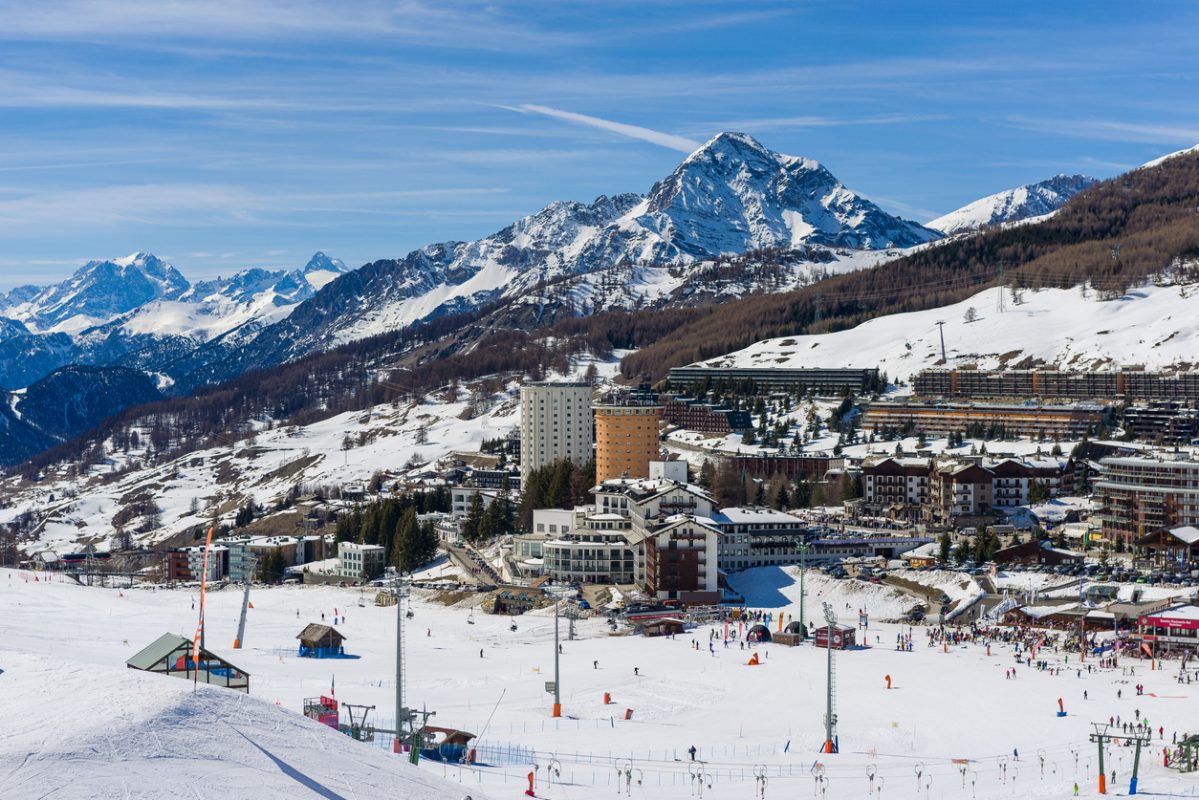
Situated around one hundred kilometres from Turin and rising to an altitude of two thousand thirty-five metres, Sestiere is one of the best Italian ski resorts.
It sits at the heart of Italy’s “Milky Way” – one of the nation’s largest interconnected ski areas.
With an impressive 400 kilometres of slopes and 71 lifts, skiers of all skill levels can find their ideal trail.
Once the sun dips behind the mountains, Sestiere’s vibrant nightlife comes alive. Embrace “la dolce vita” as you dine in one of the town’s cosy restaurants or let loose with apres-ski!
Cortina
Cortina d’Ampezzo, often referred to as the beacon of the Dolomites, stands as a sought-after winter haven in the Dolomiti Superski area.
The allure of this destination lies in its three interwoven ski resorts: Tofane, Faloria, and Cristallo, each offering a unique taste of mountain adventure.
Whether you’re taking your first tentative steps on skis or seeking new challenges to master, Cortina’s 115 kilometres of diverse slopes and 31 state-of-the-art lifts provide the ideal backdrop for growth and excitement on the snow.
Beyond the conventional, Cortina unveils a world of winter thrills with snowkiting, ice-driving, and heliskiing.
If you prefer a more tranquil connection to nature, the trails of Dolomiti d’Ampezzo Nature Park await, offering a serene exploration of Italy’s mountain grandeur.
Skiing in Switzerland
Navigate Switzerland’s slopes, surrounded by alpine panoramas and views of traditional villages.
Luxurious hotels nestle in towering mountains, each Swiss ski resort offering an unparalleled winter experience.
Why choose Switzerland? Home to the highest number of 4,000 metre peaks, it promises exceptional snow conditions and skiing with stunning vistas.
Awaiting you is a realm of pure snow and breathtaking landscapes.
Beyond skiing, the country’s cozy towns pull you away from the daily grind, creating the opportunity for a truly rejuvenating winter holiday.
Pros and cons of skiing in Switzerland
| Pros | Cons |
|---|---|
| Wide variety of ski resorts | Can be VERY expensive |
| Excellent snow conditions | Accommodation may book up quickly |
| Diverse terrain for all skill levels | Limited budget options in some areas |
| Access to high-altitude skiing | |
| Rich cultural experiences in cosy towns | |
| World-renowned facilities and instructors |
(Basically, if you can afford it, ski in Switzerland!)
Best ski resorts in Switzerland
Zermatt

In Zermatt, a Swiss resort often celebrated for having the most stunning panorama in the country, winter sports enthusiasts find themselves surrounded by 360 kilometres of meticulously groomed slopes.
These slopes span across areas like Cornergrat, Rothorn, Matterhorn Glacier Paradise, and even extend into the Italian Cervinia, all seamlessly connected by lifts.
The diversity in routes is remarkable, challenging even seasoned skiers, as more than 60% of them fall under the category of “moderate” difficulty!
Don’t be deterred if you’re just starting out, though.
Beginners will find designated areas to practice and hone their skills, ensuring Zermatt offers an unforgettable experience for all levels of adventure-seekers on the snow.
Quatre Vallées
Spanning across four valleys and eight renowned destinations, including Verbier, Veysonnaz, and Nendaz, the Quatre Vallées is a massive ski area that unites the Alpine resorts of Veysonnaz, Thyon, Nendaz, Siviez, La Tzoumaz, Verbier, and Bruson.
A network of 81 lifts and cable cars seamlessly weaves together this intricate terrain, offering a wide variety of ski experiences.
From challenging mogul slopes and steep inclines to off-piste deep snow trails and vibrant snow parks, the Quatre Vallées caters to both skiers and snowboarders of all levels.
Skiing in Austria
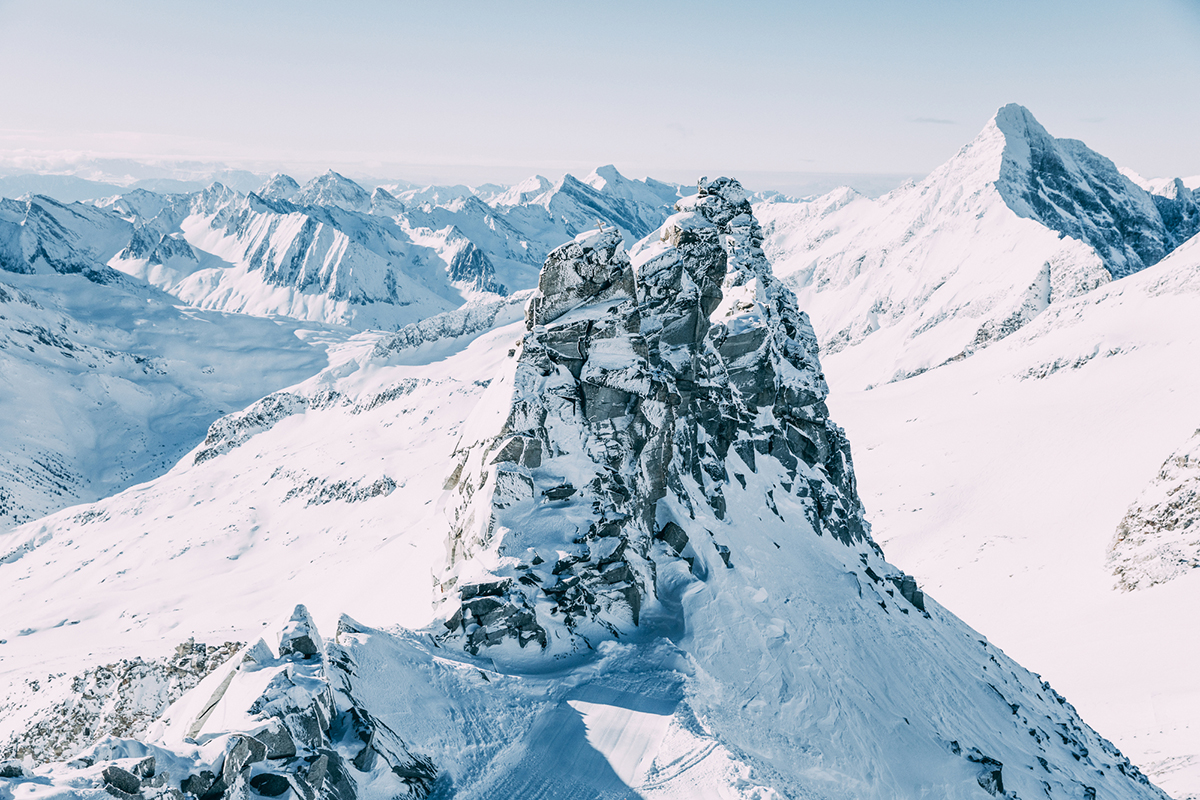
Austria’s vast mountainous terrain, with the Alps covering more than half of the country’s landscape, sets the stage for an unparalleled winter experience.
Whether you’re a skier or snowboarder, Austria’s unique Alpine climate, influenced by its residents, visitors, and rich local culture, promises a memorable journey.
Here, it’s not just about the slopes.
The charming towns, adorned with traditional Austrian architecture, offer warm hospitality and a chance to indulge in the country’s culinary delights.
From local specialities to world-famous Austrian pastries, the experience goes beyond the thrill of winter sports!
Pros and cons of skiing in Austria
| Pros | Cons |
|---|---|
| Generally more budget-friendly options compared to France and Switzerland. | Lower altitude resorts may have inconsistent snow compared to Switzerland and France (e.g., Kitzbühel vs. Zermatt). |
| Unique Austrian architecture and cuisine in towns like Innsbruck, Salzburg, and Vienna. | Popular areas like Ischgl and St. Anton can get busy during peak times, though typically less crowded than counterparts in France/Switzerland. |
| Proximity to major cities; Innsbruck to Kitzbühel, Salzburg to Ski Amadé, Vienna to Semmering. |
Kitzbühel
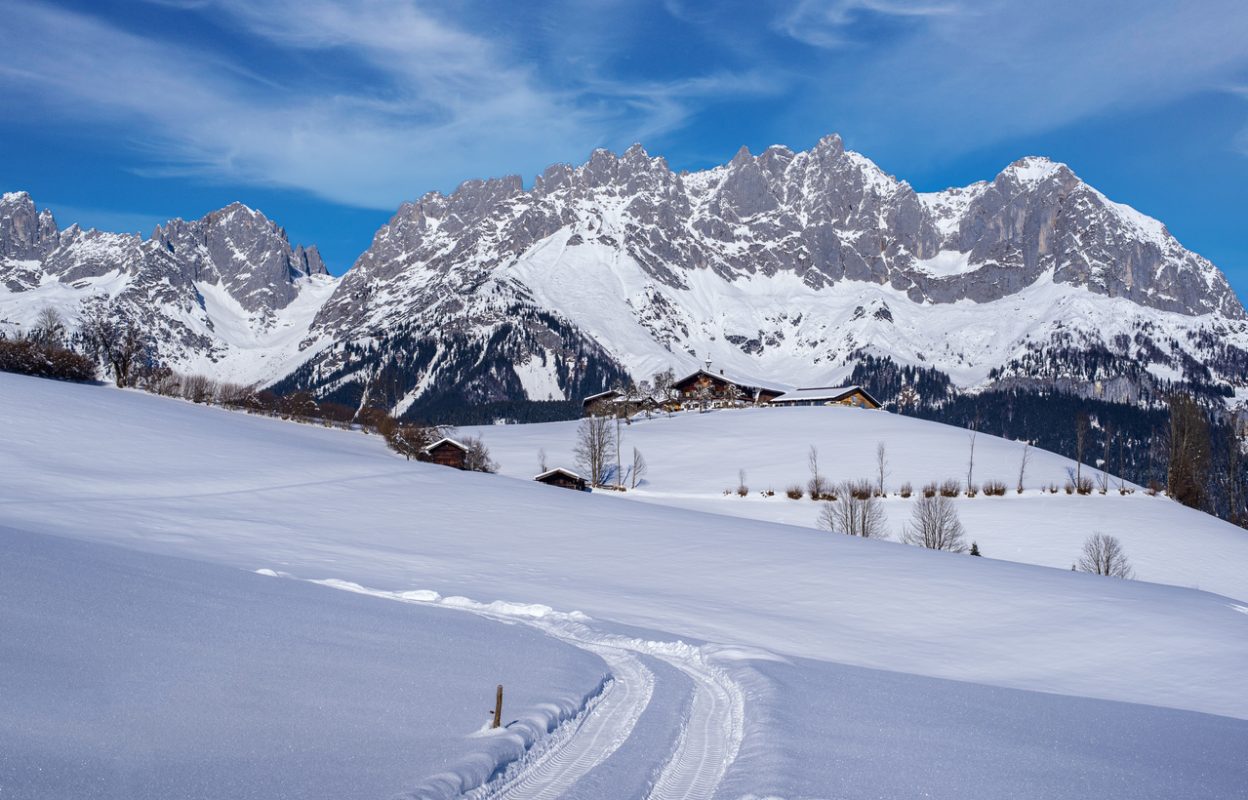
Frequently recognized as the best ski resort in the Alps, Kitzbühel stands as a distinctive destination in the Austrian Alps.
Here, the charm of a romantic town amid towering mountains blends seamlessly with the allure of a contemporary ski resort.
Expanding beyond Kitzbühel itself, the entire ski region includes the surrounding areas of Kirchberg, Jochberg, Aschau, Hollersbach, and Mittersill. Together, they offer an impressive network of over fifty cable cars and lifts.
Skiers and snowboarders will find one hundred seventy-nine kilometres of runs at their disposal, promising adventure and excitement at every turn.
The Kitzbuhel region caters to various skill levels, with a wide array of downhill skiing routes tailored for average to skilled enthusiasts.
For the highly experienced, the real thrill might lie in conquering Streif.
Known as one of the most challenging routes, professionals brave this slope during the annual quest for supremacy in the Alpine World Cup competition.
Anton am Arlberg
Nestled in a picturesque mountain landscape, the Arlberg ski region straddles the border with the Austrian state of Vorarlberg.
Comprising five fantastic ski resorts—St. Anton, St. Christoph, Stuben, Lech, and Zuers—it offers an impressive array of over three hundred fifty kilometres of pistes.
It’s not just about the numbers though. The off-piste opportunities here are ranked among the best in the world.
Don’t worry if you’re a beginner or an intermediate skier – you’ll still find the local routes brimming with opportunities.
Skiing in Spain
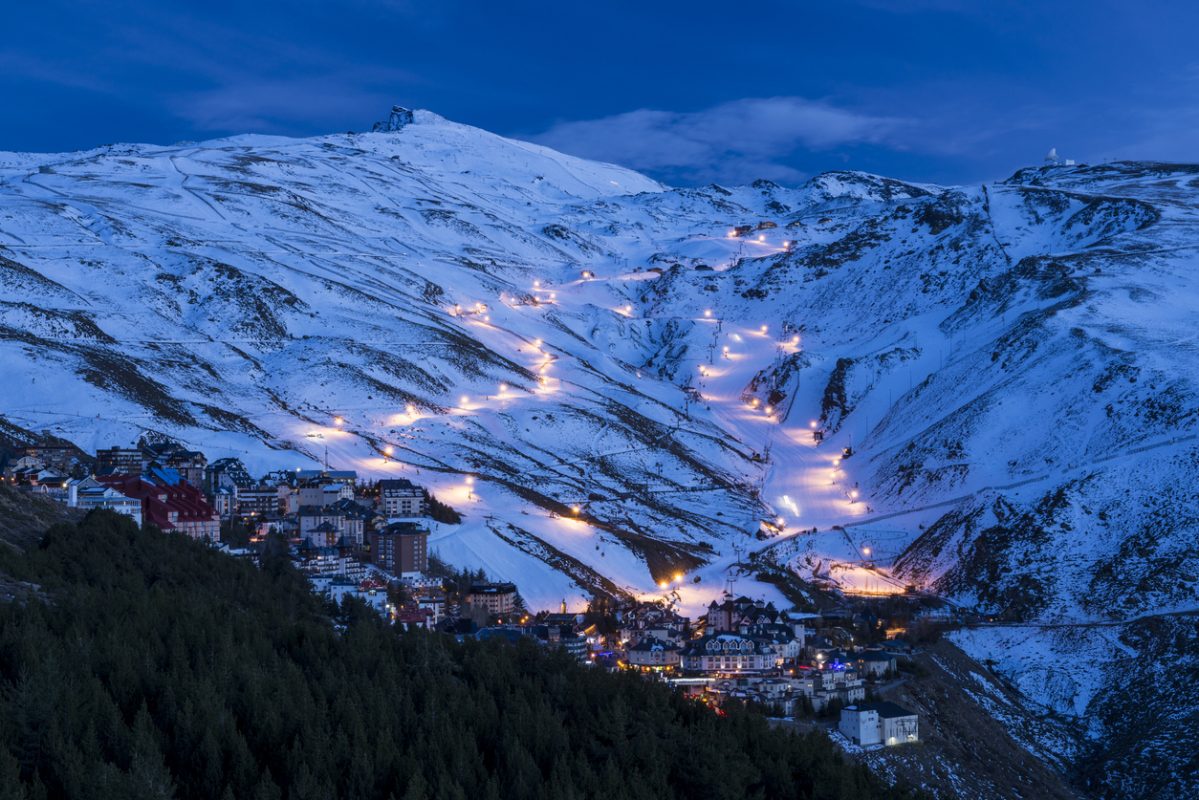
Spain might be renowned for its sandy beaches, sun-kissed coastlines, and inviting warm climate, but that’s not all it has to offer.
If you’re a lover of white slopes and thrilling ski experiences, don’t overlook this sun-loving nation for your European ski trip.
You may not think of Spain as your first choice for a ski trip, but here’s why you should reconsider.
The Pyrenees are part of Spain itself, providing excellent ski resorts with top-notch conditions.
And if you think the Pyrenees are your only option, think again! Spain is also home to Sierra Nevada, Europe’s southernmost ski resort.
These winter wonderlands may be a five-hour bus ride away from the bustling streets of Barcelona, but they’re well worth the journey.
Plus, you can easily visit Spain’s coastal regions and enjoy some winter sunshine in the same trip!
Pros and cons of skiing in Spain
| Pros | Cons |
|---|---|
| Diverse range of ski resorts in the Pyrenees | Fewer world-renowned resorts compared to the Alps |
| Sierra Nevada offers unique southern skiing | Season length can be shorter in some areas |
| Proximity to cultural cities like Barcelona | Can be crowded during peak seasons |
| Generally more affordable than other European destinations | Inconsistent snowfall in some regions |
| Variety of activities beyond skiing | Limited options for extreme ski enthusiasts |
| Unique fusion of Spanish culture and cuisine |
Best ski resorts in Spain
Baqueira-Beret
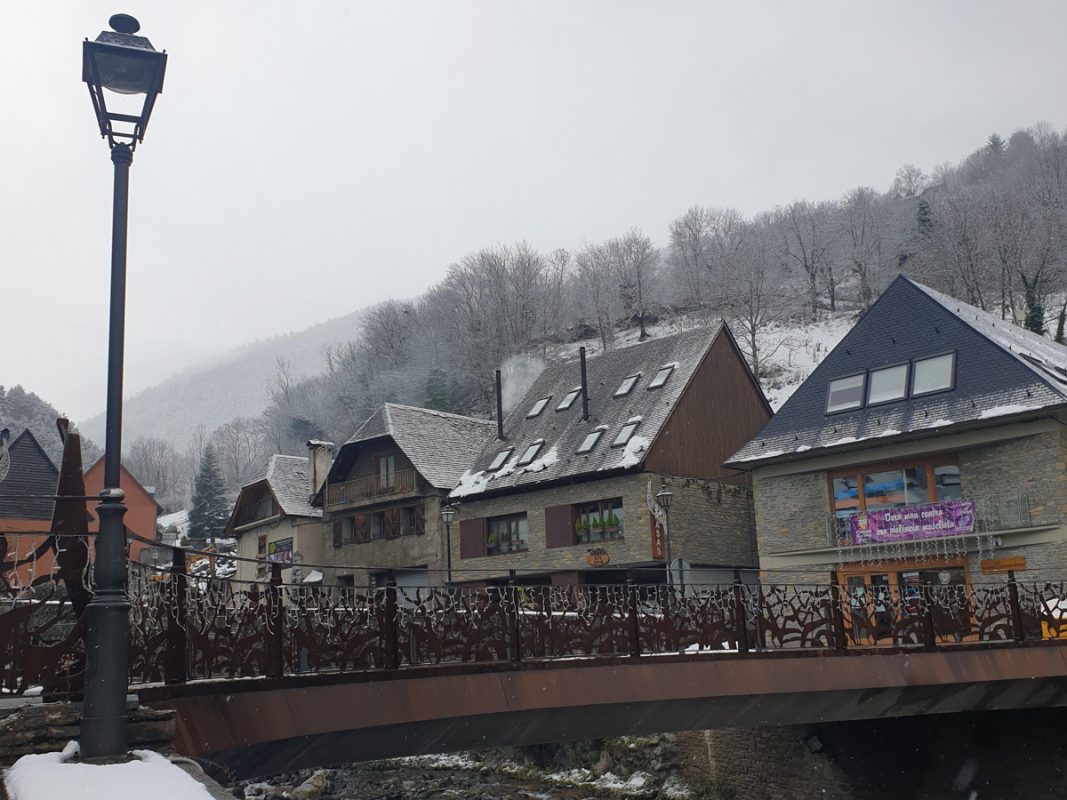
Renowned as the largest, best-maintained, and most frequented ski resort in Spain, Baqueira-Beret graces the Arán Valley in the Catalan Pyrenees.
This expansive resort is strategically divided into three areas: Baqueira, Beret, and Bonaigua. Together, they present thirty-three ski lifts, one hundred and four routes, and one hundred sixty-two kilometres of ski terrain.
Catering to different preferences and skills, the resort extends a wide assortment of downhill runs. From novices to seasoned skiers, everyone will find trails tailored to their abilities.
The picturesque surroundings, nearby atmospheric towns like Vielha – one of my favourite European destinations for December – and exceptional skiing conditions contribute to its charm.
A generous selection of hotels and restaurants awaits, adding to the reasons why this resort is a favoured destination for visitors across Europe!
Sierra Nevada
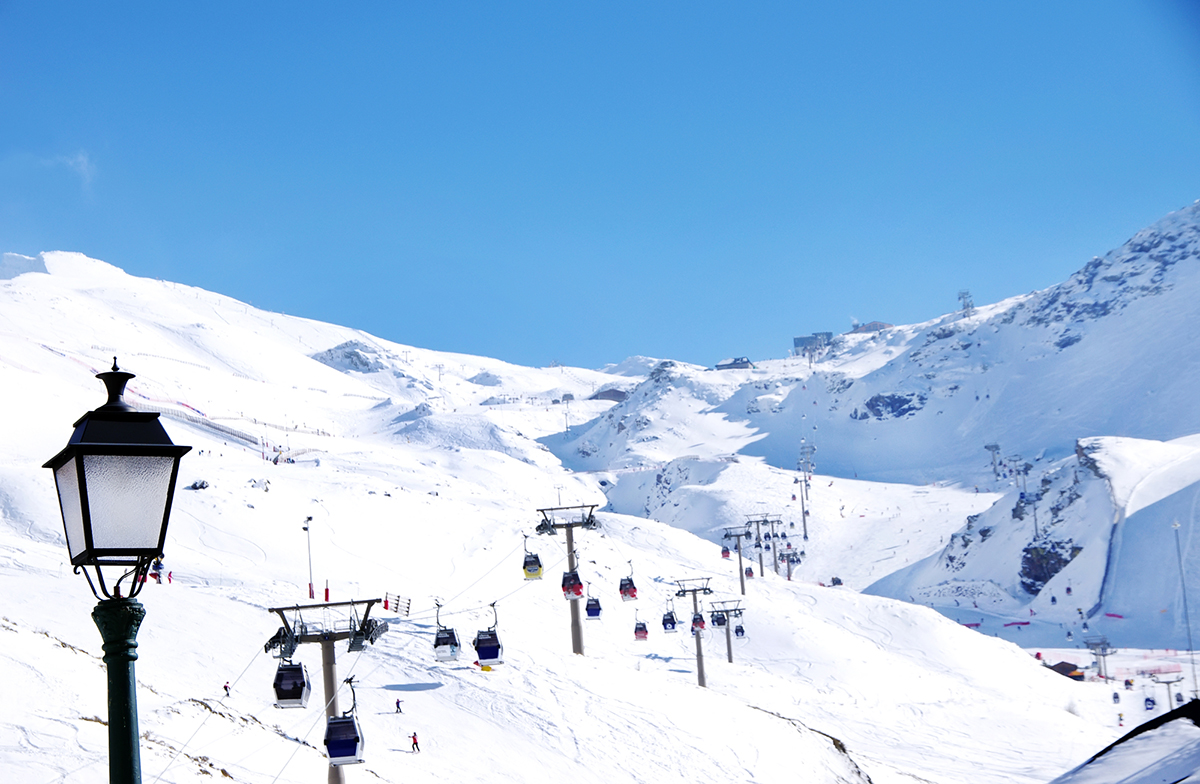
The Sierra Nevada, positioned in southern Spain within the Penibético mountain range, spans over ninety kilometres of skiing terrain.
This distinct resort is organized into six specialized ski areas: Veleta, Laguna de las Yeguas, Borreguiles, Loma Dílar, Parador y Río.
Combined, they offer thirty lifts and one hundred and three unique routes, categorized as sixteen green, thirty-five blue, forty-three red, and nine black.
Beyond the slopes, Sierra Nevada boasts a Snow-Park, cross-country skiing trails, Saturday night skiing, and snow golf.
Whether you’re interested in testing cars on a dedicated track, constructing igloos, tobogganing, enjoying nighttime snowmobile rides, or skating on artificial ice, Sierra Nevada promises a vibrant array of winter activities – and it’s close to Granada, Seville and even Malaga!
Skiing in Germany
Germany might not be your first choice for winter sports – it’s much more famous for its Christmas markets in the winter!
But the Alps cross over into the southern part of the country, and here you’ll find a variety of ski areas ready to challenge even the most seasoned skiers.
Pros and cons of skiing in Germany
| Pros | Cons |
|---|---|
| Variety of ski regions suitable for all skill levels | Fewer internationally renowned resorts |
| Accessibility from major cities | Season may be shorter in lower-altitude areas |
| Bavarian hospitality and unique traditions | Less extensive ski areas compared to neighboring countries |
| Often more affordable than other Alpine destinations | Possible crowded slopes near urban areas |
| Opportunities to combine skiing with cultural experiences |
Best ski resorts in Germany
Garmisch-Partenkirchen
The famous Garmisch-Partenkirchen may already be on your radar as the site of The Four Hills Ski Tournament.
Located in Bavaria, right in the heart of the Alps, it lies close to Germany’s highest mountain, the Zugspitze Glacier. This towering peak reaches almost 3,000 meters!
With a total length of 62 kilometers of runs, you’ll have plenty to explore.
A whopping 90 kilometers of these are blue routes, perfect if you’re looking for something more laid-back.
If you’re after a greater challenge, you might find the 43 kilometers of red routes more to your liking.
And for the thrill-seekers among you, there are 9 kilometers of black routes waiting to be conquered.
This mix of terrains makes Garmisch-Partenkirchen one of Germany’s most famous and versatile ski resorts. Don’t miss the chance to experience it for yourself!
Brauneck – Lenggries
Brauneck – Lenggries, have you heard of it? It’s one of the most interesting, and certainly more traditional ski resorts in Bavaria.
Located a mere 60 km from Munich, it’s conveniently close to the city.
What sets this place apart? It’s the multitude of mountain huts, 16 in total, all nestled on the slopes. It’s a charm you won’t want to miss.
Now, let’s talk about the runs. Brauneck offers a total of 34 kilometers for you to explore.
Starting with 8 blue easy runs, perfect for a relaxed glide down the slopes.
Feeling a bit more adventurous? There are 22 intermediate red runs to challenge yourself on.
And for those who crave intensity, four difficult black runs are there for the advanced skiers.
But skiing isn’t the only thing to love here. The region is famed for its charming Bavarian hospitality. You can not only enjoy a meal at one of the mountain huts but also spend the night, use the sauna, or warm up by the fireplace.
In Brauneck – Lenggries, the slopes are just the beginning of a truly unique experience. Will you be visiting?
Skiing in Poland
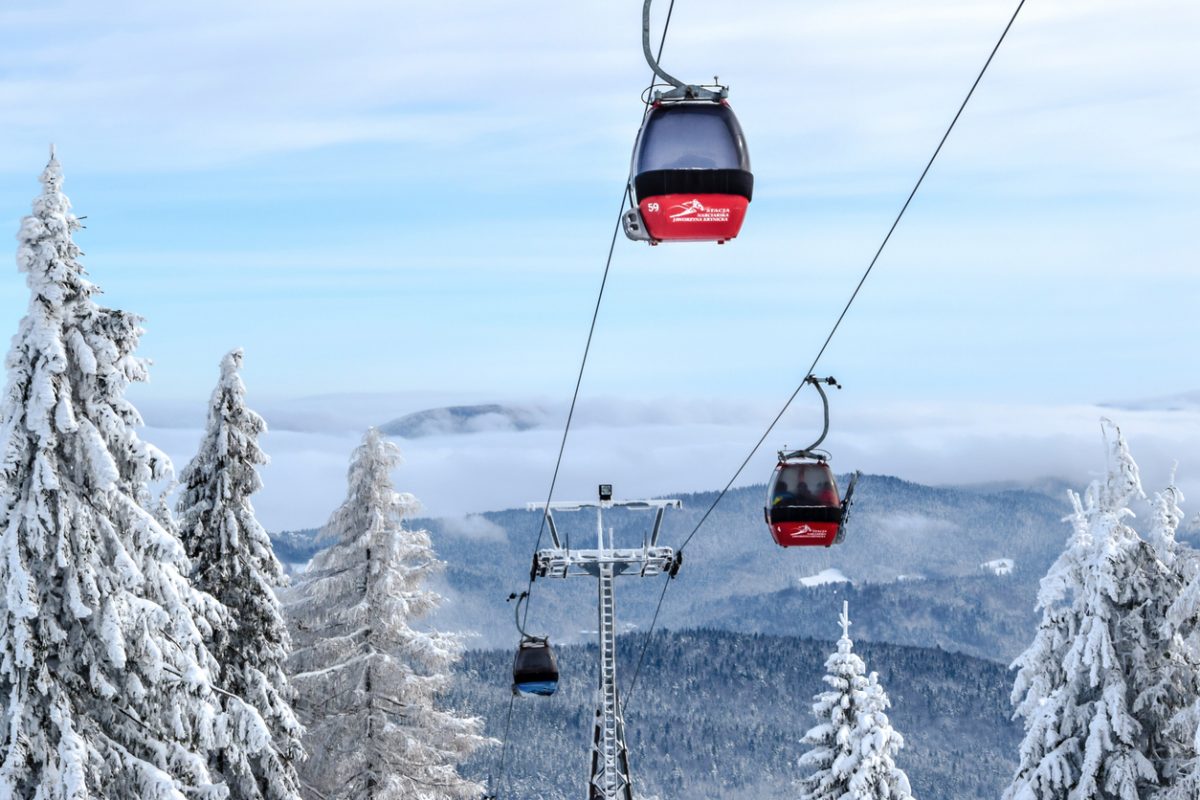
Poland is emerging as an enticing destination for your next skiing adventure, thanks to reliable snow and staggering mountains.
With the ski infrastructure constantly blossoming and the promise of affordability, it’s an option worth considering.
Did you know? There are nearly 500 kilometres of ski slopes in Poland, beckoning you with their allure.
Whether you’re just starting out on your skiing journey or an experienced pro on the snowboard, Poland’s diverse selection of ski resorts has something in store.
From gentle beginner-friendly slopes to the more challenging terrains, you’ll find the perfect place to carve your path down the mountain.
Pros and cons of skiing in Poland
| Pros | Cons |
|---|---|
| Affordable compared to many Western European destinations. | Some ski areas may lack advanced facilities. |
| Almost five hundred kilometres of slopes catering to all levels. | Reaching some resorts might be less convenient. |
| Experience unique local culture, cuisine, and traditions. | Options may be limited for expert skiers. |
Kotelnica – Białka Tatrzańska
If you’re planning a trip to Podhale and can’t decide between downhill or cross-country skiing, Kotelnica Białczańska might be the perfect destination for you.
Here, you’ll find excellent downhill runs totalling 14 kilometers, as well as several kilometers of top-notch cross-country tracks.
Are you interested in variety? The resort offers as many as 25 distinct ski runs: four difficult routes, 12 easy routes, four very easy routes, and even a garden designed for children.
Whether you’re a beginner or an intermediate skier, you’ll find plenty of options to suit your skill level.
And if you’re an experienced skier looking for a challenge, you won’t be left out; the interesting black runs ensure that even the most skilled among you won’t find yourselves bored here.
Szrenica Ski Arena – Szklarska Poręba
If you’re thinking about a ski adventure in Poland, you might want to consider the station located in Szklarska Poręba. Situated in the Lower Silesia Province, at the border of the Izera Mountains and the Karkonosze Mountains, this resort is the largest and oldest climatic center in the region.
One of the primary attractions here is the Szrenica Ski Arena in Szklarska Poręba. Are you a skiing enthusiast? This arena provides something for all levels with its five routes, including two difficult, two easy, and one very difficult run.
Known as the largest ski resort in the Polish Karkonosze Mountains, Ski Arena Szrenica offers an impressive 11 kilometers of high-altitude slopes. Whether you’re a novice or an expert, you’re sure to find the perfect slope for your skill level in this picturesque setting.
Zakopane
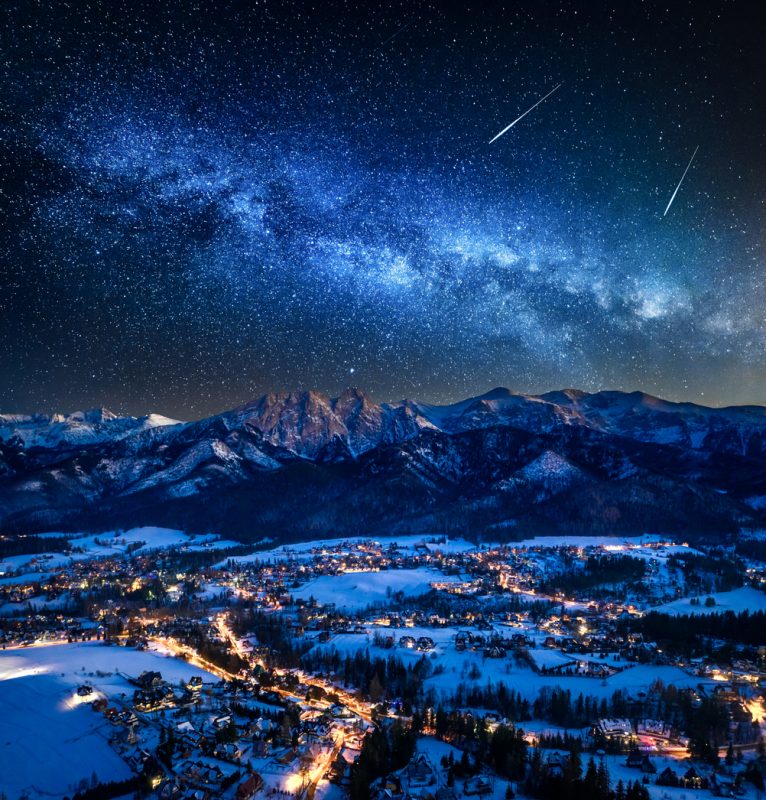
Zakopane is often referred to as the “Winter Capital of Poland,” and if you find yourself heading there, you’ll quickly understand why. Located in the Tatra Mountains, this renowned resort town offers a wide array of skiing opportunities.
Are you a seasoned skier or just starting out? Zakopane has something for everyone, from challenging black runs to gentle beginner slopes.
The Kasprowy Wierch and Gubałówka mountains offer thrilling downhill experiences, while Nosal Mountain is a haven for beginners.
Don’t forget to indulge in the local culture and cuisine.
From traditional wooden architecture to hearty Polish dishes, Zakopane provides a truly immersive experience both on and off the slopes.
Wisła
Wisła, situated in the Silesian Beskids mountain range, is an alluring destination for ski lovers and one of the best places for winter in Poland.
Known for its breathtaking landscapes and varied ski runs, Wisła is a charming place to explore on skis or a snowboard.
Whether you’re looking for a relaxing run down a gentle slope or craving the adrenaline rush of a steep descent, Wisła has something to offer.
The Nowa Osada and Cieńków ski stations cater to all skill levels and provide well-maintained routes to enjoy.
Have you considered trying cross-country skiing?
Wisła is an ideal place to venture into this unique winter sport, with miles of picturesque cross-country trails.
But Wisła is not just about skiing; it’s also about soaking in the local traditions, enjoying the hospitality, and tasting the culinary delights of the region.
After a day on the slopes, you can unwind and relish the Polish mountain lifestyle.
Skiing in the Czech Republic
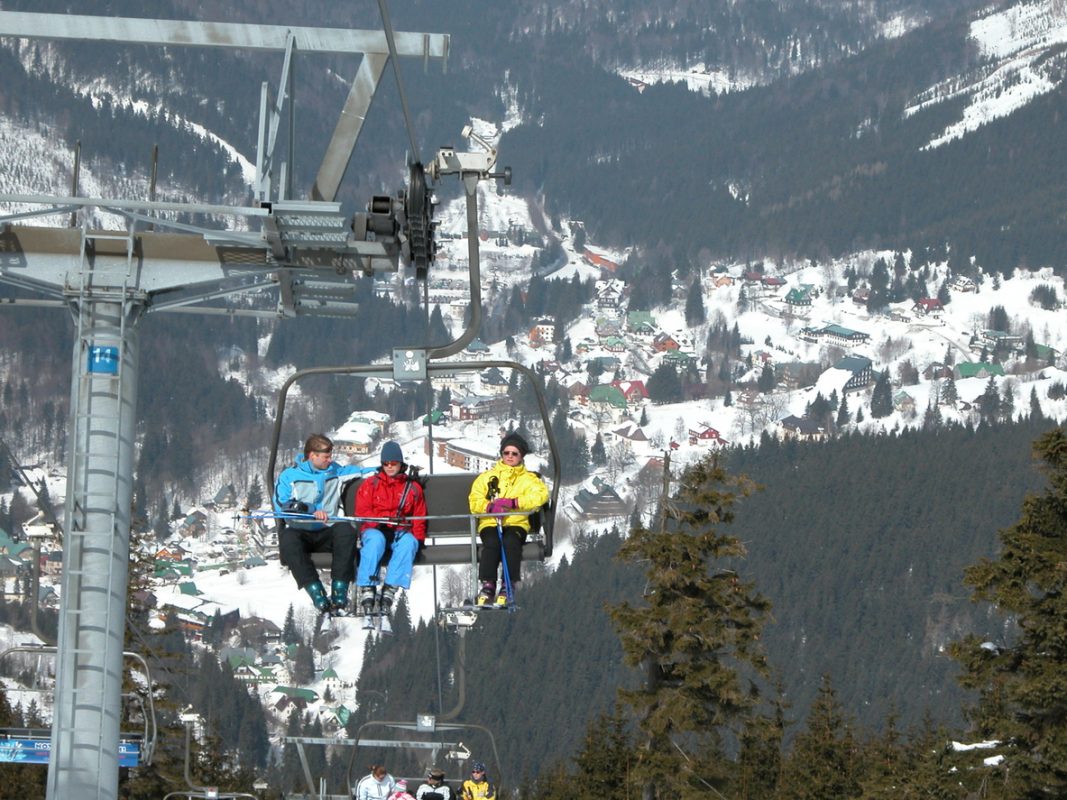
Have you ever considered the Czech mountains for your next skiing adventure? If not, maybe it’s time to give them a second look.
The Czech Republic offers something a bit different for winter sports enthusiasts, especially those looking to escape the hustle and bustle of more crowded resorts.
Almost the entire country is upland-mountainous, providing a unique terrain that keeps the snow stable for longer periods.
Worried about the thaw? You can leave those concerns at home.
The warm air masses that might bring melting snow have a tough time reaching these parts, ensuring crisp, reliable snow conditions.
From the Krkonoše Mountains, home to the country’s highest peak, to the lesser-known Jeseníky range, the Czech Republic offers a variety of skiing options to suit all levels of experience.
Whether you’re a seasoned pro or just starting out on the slopes, the Czech mountains could be the tranquil, picturesque setting you’ve been searching for!
Pros and cons of skiing in Czechia
| Pros | Cons |
|---|---|
| Smaller crowds at lifts | May lack the glamour of more famous ski resorts |
| Stable snow conditions due to upland-mountainous terrain | Limited very high-altitude skiing options |
| Variety of skiing options for all skill levels | Fewer luxurious amenities compared to other European destinations |
| Picturesque and tranquil settings | Travel accessibility might vary by region |
| Generally more affordable compared to Western European destinations | Some areas might have limited English-speaking staff |
Best ski resorts in Czech Republic
Špindlerův Mlýn
The Špindlerův Mlýn ski complex consists of the Svatý Petr and Medvědín resorts, and you’ll be glad to know that one ski pass gives you access to both.
Boasting its status as one of the largest ski complexes in the Czech Republic, it offers 17 ski lifts and 27 ski runs of various difficulty levels. Whether you’re a beginner or an expert, you’ll find something to challenge and excite you here.
And if you’re a fan of cross-country skiing, there are several dozen kilometers of trails waiting for you to explore.
But the fun doesn’t stop with skiing! Špindlerův Mlýn offers plenty more to keep you entertained. Fancy a thrilling ride down a bobsleigh track? Or perhaps a glide down a sledge slope? You’ll find these here too.
And for something truly unique, you can test your skills on an ice wall or skate around an ice rink. With so much to offer, Špindlerův Mlýn ensures that every visitor leaves with unforgettable memories.
Keilberg (Klínovec)
If you’re on the hunt for tranquillity in a beautiful white mountain landscape, don’t overlook Klínovec. Located in the Ore Mountains in the Czech Republic, and close to the border with Germany, this area offers a serene escape.
As you hit the slopes at Klínovec, you’ll find over 30 kilometers of trails to explore, catering to all levels of difficulty. And the best part? The snow conditions here remain excellent all season long, giving you the perfect terrain to hone your skills.
Skiing is just the beginning at Klínovec.
You’ll be spoiled for choice when it comes to dining, with a wide range of restaurants and eateries to suit every palate.
Need to rent equipment or brush up on your techniques? No problem! Equipment rental and ski schools are readily available. If you’re traveling with little ones, you’ll appreciate the childcare services on offer.
And when the day is done, you can unwind at the latest après ski bar or find a cozy place to stay from the large selection of accommodation options.
With its comprehensive services and stunning surroundings, Klínovec is a destination that should be on every skier’s list. Whether you’re a seasoned pro or just starting out, you’ll find something to love in this mountain haven.
Skiing in Slovakia

Slovakia as a skiing destination? Many overlook this beautiful Central European country for winter sports, yet Slovakia’s offerings are worth attention.
The unique landscapes of Slovakia enthrall, and professional ski resorts are strategically positioned to showcase the country’s natural beauty.
Whether you’re a seasoned skier or just starting on the slopes, Slovakia’s resorts have something to offer.
Ski areas in Slovakia are designed to be part of your winter adventure, with services crafted to meet every need.
Slovakia’s ski resorts have earned a reputation for top-notch facilities and services. From challenging runs to test your skill to beginner-friendly slopes for those just starting, Slovakia delivers.
Pros and cons of skiing in Slovakia
| Pros | Cons |
|---|---|
| Affordable pricing compared to other European destinations | May be less well-known, leading to uncertainty |
| Diverse range of slopes catering to all skill levels | Smaller crowds may mean fewer amenities |
| Unique landscapes and beautiful natural scenery | Limited international flights to some ski regions |
| Professional ski resorts with modern facilities | Language barrier may be an issue for some visitors |
| Opportunities for other winter sports and activities | Some resorts might not have as extensive grooming |
| Good snow conditions throughout the season |
Best ski resorts in Slovakia
Jasná Nízke Tatry – Chopok
Are you thinking about a ski trip to Slovakia? You might want to consider Jasna Low Tatras, one of the largest ski stations in the entire country.
Located within the Low Tatras National Park, this resort gives you access to the Chopok slope, which boasts the second-longest Slovak ski run.
With 41 routes spanning a total length of 50 kilometers, there’s a vast playground for skiers to explore.
23 lifts, including five gondolas, ensure that getting around the resort is a breeze.
For the adrenaline-seekers among you, there are also 12 freeride zones waiting to be conquered!
Whether you’re a beginner or a seasoned pro, the slopes at Jasna Low Tatras have something to offer.
Tatranská Lomnica
Planning a ski trip in the Slovak Tatras? Tatranská Lomnica might just be the perfect destination for you!
As the largest, most popular, and highest-situated ski resort in the region, Tatranská Lomnica offers something for everyone.
The complex is neatly divided into two ski areas: Skalnate Pleso and Jamy. You won’t have any trouble finding your ideal run here, with a vast array of specially prepared slopes catering to all difficulty levels.
Are you an experienced skier? Then you’ll want to challenge yourself on the Łomnicka Pass, the highest and steepest route in the area.
Families with children will also find plenty to love, as the variety of runs ensures fun for all ages and skill levels.
What sets Tatranská Lomnica apart is its outstanding infrastructure. With a large number of lifts facilitating easy movement around the entire area of the High Tatras, you can maximize your time on the slopes.
And after a day of skiing, you’ll find a huge base of hotels and restaurants ready to cater to your every need.
Whether you’re a demanding skier or looking for a relaxing family getaway, Tatranská Lomnica offers an unforgettable experience.
Skiing in Hungary
Hungary might not be the first place that springs to mind when planning a skiing trip, but did you know that it does have something to offer winter sports enthusiasts?
It’s true that Hungary’s topography isn’t especially mountainous, with the highest hill barely reaching over one thousand meters above sea level.
Yet, if you’re in search of a unique skiing experience, Hungary might have something to pique your interest.
Though it might lack the grandeur and variety of traditional ski destinations, Hungary offers a charming alternative for those looking to stray from the well-worn path.
The experience here is different, local, and genuine. If that sounds appealing to you, Hungary’s modest yet intriguing ski scene could be worth a closer look!
Pros and cons of skiing in Hungary
| Pros | Cons |
|---|---|
| Unique and less-crowded skiing experience | Limited topography (not very mountainous) |
| Appeals to those seeking unconventional ski destinations | Small number of ski resorts |
| Opportunity to explore a non-traditional ski destination | Primarily attracts locals, potentially limiting the international community and amenities |
| A more local and genuine experience | Lack of variety and challenges for advanced skiers |
| Possibly more affordable than popular ski destinations | Less developed skiing infrastructure and facilities |
Best ski resorts in Hungary
Síaréna Vibe Park – Eplény
In the ski resort Síaréna Vibe Park – Eplény, you’ll find a variety of slopes catering to every skill level, spanning almost eight kilometres.
There are eight lifts ready to whisk you to the top, so you can explore everything from completely beginner-friendly tracks to areas for more advanced skiers, and even some particularly challenging steep slopes.
Eplény enjoys long ski seasons, even when the weather isn’t cooperating.
This is thanks to the resort’s modern and efficient snowmaking capacity, ensuring that a lack of natural snow doesn’t dampen your winter fun.
Skiing in Romania
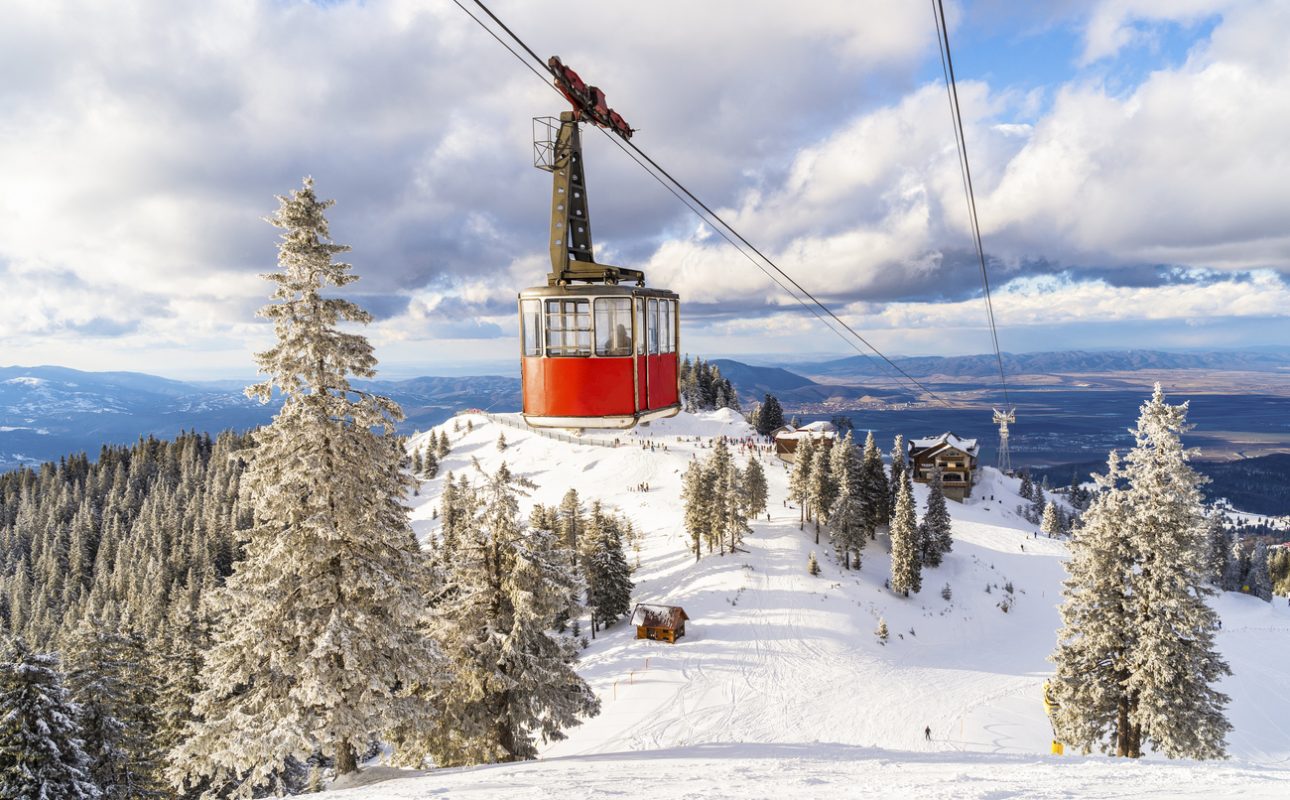
Romania, with its wild Carpathian routes and charming, remote villages, is capturing the hearts of more and more travellers.
Covering a third of the country’s territory, the Carpathian Mountains are a haven for wildlife enthusiasts, ski touring fans, and freeriding aficionados.
Whether it’s the thrill of off-the-beaten-path adventures or the allure of well-maintained ski runs, Romania’s Carpathian Mountains have something for every winter sports enthusiast.
Pros and cons to skiing in Romania
| Pros | Cons |
|---|---|
| Diverse skiing options including ski touring and freeriding | Limited international recognition of ski resorts |
| Rich natural landscapes and wildlife | Some areas may lack modern facilities and amenities |
| A growing number of ski resorts with good infrastructure | Seasonal weather may be inconsistent |
| Affordability compared to more renowned European ski areas | Accessibility might be challenging in some remote areas |
| Unique cultural experiences in charming Romanian villages | Limited options for highly advanced skiers |
Best ski resorts in Romania
Poiana Brasov

Poiana Brașov, near Brasov, serves as the winter capital of Romania and presents an appealing destination for ski enthusiasts.
With approximately 20 kilometres of medium-difficulty slopes, it’s not just the runs that attract visitors.
A wealth of amenities awaits you, including extensive restaurant and hotel facilities, a water park, and a spa centre.
If quieter places are your preference, you might find solace in Poiana Brașov. Unlike resorts located on main railway routes, it’s not overwhelmed by masses of tourists and tends to attract devoted skiers.
Feel like testing your skiing prowess?
You have a choice of eight diverse routes at Poiana Brașov.
Whether it’s the slalom, giant slalom, or the Olympic track, a thrilling experience awaits you, with options for advanced skiers and those eager to push their limits.
Sinaia
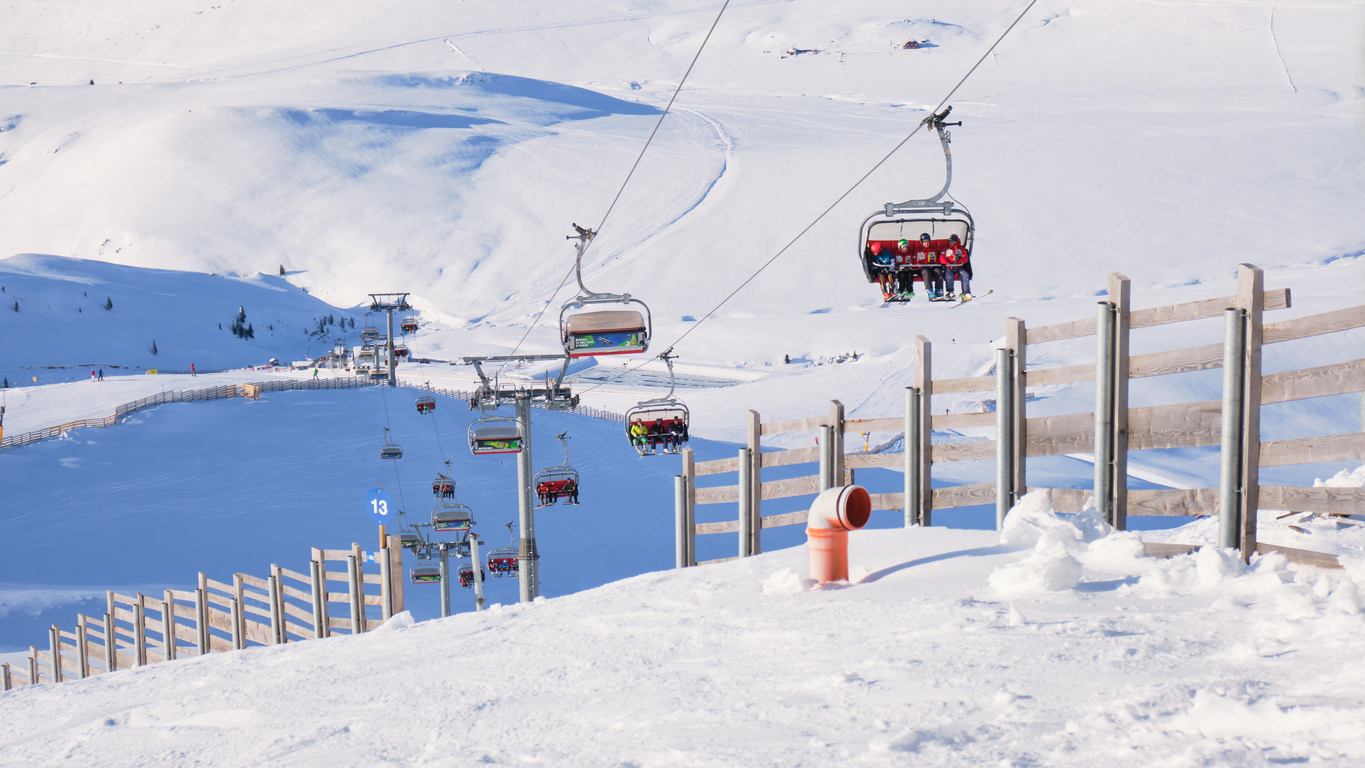
Sinaia, often hailed as the cradle of winter sports in Romania, beckons skiers looking for a mix of complexity and challenge.
The ski slopes in this resort span altitudes ranging from 400 to 2,800 hundred metres along 40 kilometres of ski slopes.
If you prefer cross-country skiing, there’s an eight-kilometre trail awaiting.
The resort may not be suitable for complete beginners, but if you have some experience under your belt, Sinaia’s challenging ski area could be just the adventure you’re looking for!
Skiing in Bulgaria
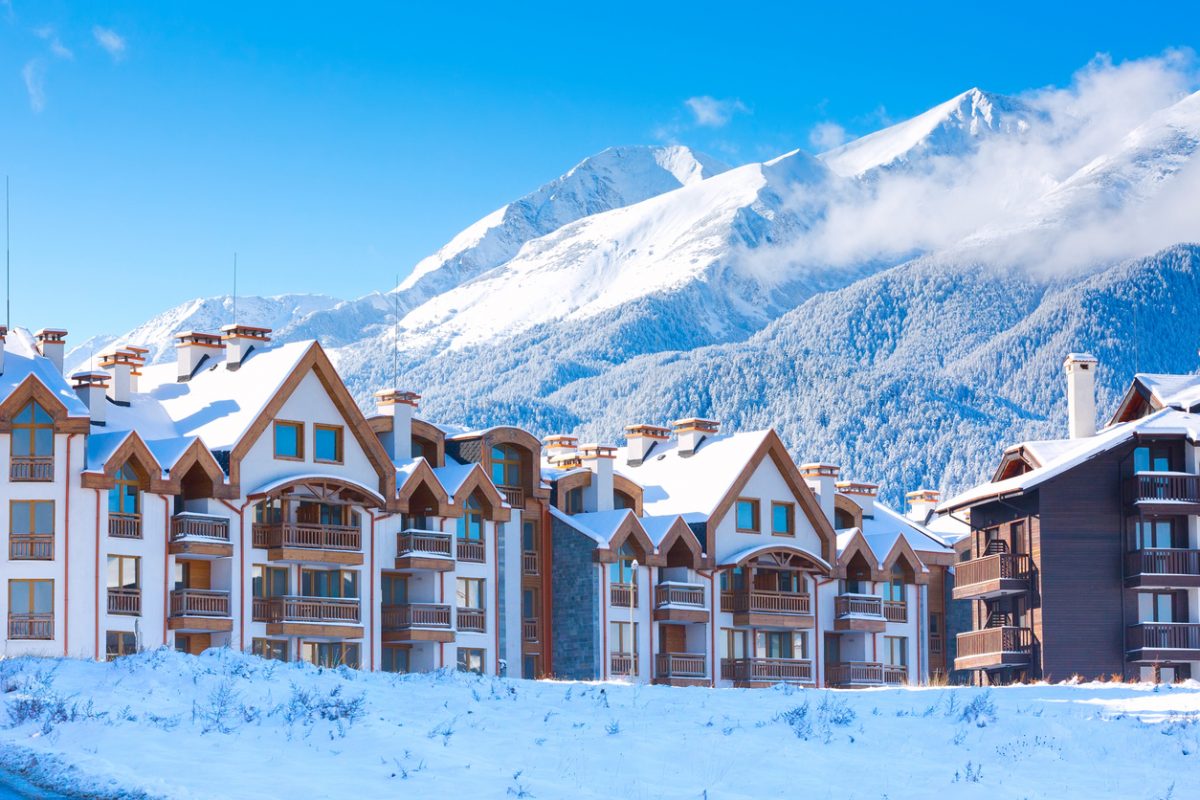
Well-kept infrastructure, affordable prices, and lingering snow that lasts until the end of April – if these factors are high on your list, then Bulgaria might be your ideal ski destination.
Did you know that the mountains cover almost 30% of Bulgaria’s surface?
This not only adds to the country’s traditional tourist attractions but also offers a wide array of ski resorts to choose from.
Whether you’re a solo adventurer or planning a fun-filled family winter vacation, Bulgaria’s growing popularity as one of the cheapest ski destinations in Europe is sure to catch your attention!
With an increasing number of visitors exploring its slopes, Bulgaria continues to thrive as an attractive option for ski enthusiasts on a budget.
If you’re looking for a mix of quality and affordability, you might want to consider Bulgaria for your next ski trip!
| Pros | Cons |
|---|---|
| Affordable prices for accommodation and ski passes – you can often find cheap flights too! | Some resorts may lack advanced facilities |
| Snow that lasts until the end of April | Less recognized globally compared to other European destinations |
| Variety of ski resorts catering to all skill levels | Potential language barriers with local staff |
| Increasingly popular family winter destination | Limited après-ski activities in some areas |
| Well-kept infrastructure | Seasonal crowds may lead to longer wait times |
| Rich cultural experience and traditional attractions | Might not challenge highly experienced skiers |
Borovets
Borovets, just 72 kilometres from Sofia – the capital of Bulgaria – might be the perfect choice if you’re looking to combine a ski holiday with some sightseeing around a historic capital.
As a large resort, Borovets offers something for everyone: 24 kilometres of beginner-friendly blue runs, 30 kilometres of intermediate red runs, and five challenging kilometres of black runs.
Consisting of three distinct parts – Markudjik, Yastrebetz, and Sitnyakovo – you’ll find a diverse range of slopes.
Whether you’re a novice or an expert skier, Borovets offers an appealing blend of skiing and culture.
Bansko

The Bansko ski resort is located in the Pirin mountain range in southwest Bulgaria, 160 kilometres from the capital, Sofia.
The total length of the pistes is 70 kilometres.
With a thoughtful division of 30% for beginners, 45% for intermediate, and 35% for advanced skiers, it offers something for everyone.
160 snow cannons keep the pistes in perfect condition throughout the season.
Not only regular skiers but also snowboarders and cross-country skiers will find Bansko an appealing destination, thanks to its well-maintained slopes and diverse offerings.
Skiing in Turkey
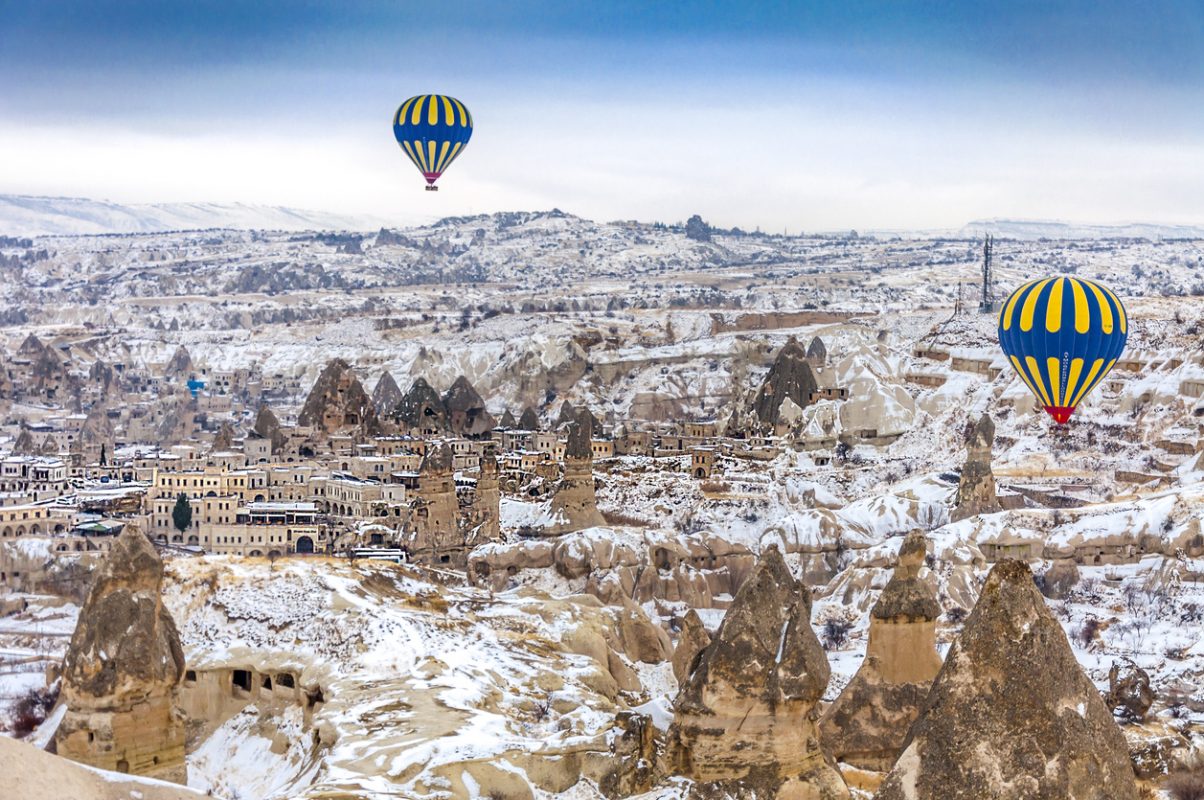
Turkey isn’t just about beautiful beaches and historic landmarks – it snows a lot in some parts of the country, and it’s a growing destination for winter sports enthusiasts.
There are 37 ski resorts in the country, and they are garnering more attention from both local and foreign tourists.
Whether you’re an avid skier or just looking for a new winter adventure, Turkey’s ski resorts might just be the unexpected destination you’ve been searching for.
Pros and cons of skiing in Turkey
| Pros | Cons |
|---|---|
| 37 ski resorts to choose from. | Some resorts may not be as well-developed. |
| Growing Popularity: Enhanced facilities and infrastructure. | Accessibility: Reaching some ski resorts might be challenging. |
| Unique Cultural Experience: Rich Turkish heritage. | Limited Season: Shorter ski seasons. |
| Cost-Effective: More affordable than traditional European destinations. | Language Barrier: Potential communication challenges. |
| Good Snow Conditions: Reliable during the season. | Variable Quality: Facilities might differ across resorts. |
Erciyes – Kayseri
Erciyes, named after an extinct volcano – the tallest in Cappadocia, offers great conditions for winter sports enthusiasts.
Both beginners, advanced skiers, as well as freeride enthusiasts will find their place in Erciyes on various routes.
Located 60 kilometres from the city of Kayseri, Erciyes Ski Resort offers 34 different ski runs, ranging from easy to difficult, with a total length of 102 kilometres.
Sarikamis – Kars
The Sarıkamış Ski Centre is known for its extreme skiing conditions and is among the most thrilling options for winter sports enthusiasts.
With a ski area of 1,844 metres in length and two ski resorts, Sarıkamış’ climate provides a lengthy cold and snow-covered season, making it perfect for skiers and snowboarders looking for a challenge.
Kartepe
Kartepe, located in the region of Kocaeli, is one of Turkey’s most accessible ski resorts, attracting both locals and tourists.
Situated just 120 kilometres from Istanbul, it’s a favorite for weekend getaways.
Kartepe offers 14 ski runs with different levels of difficulty, making it suitable for both beginners and seasoned skiers.
The total length of the runs is 21 kilometres.
Besides skiing, there’s a selection of non-skiing activities available, from trekking to snowboarding, adding to its appeal.
Uludağ
Uludağ is Turkey’s premier ski resort, located in the Bursa Province.
Known as the “Grand Mountain,” Uludağ reaches a height of 2,543 metres and provides 28 kilometres of ski slopes.
The resort caters to skiers of all levels, with 13 lifts, eight blue runs, seven red runs, and three black runs.
It’s particularly popular for its night skiing!
With a wide variety of hotels, restaurants, and après-ski activities, Uludağ’s well kitted for ski trips.
If you’re interested in combining your ski trip with some culture, the historic city of Bursa is nearby and worth a visit.
It’s not too far from Istanbul too!
Skiing in the Baltics
While the Baltic states of Lithuania, Latvia, and Estonia may not be traditional ski destinations, they have made creative use of the natural landscape to offer unique winter sports experiences.
Pros and cons of skiing in the Baltics
| Pros | Cons |
|---|---|
| Various small ski resorts for different levels | Limited vertical drops and elevation |
| Indoor skiing available at Druskininkai Snow Arena | Limited challenges for advanced skiers |
| Scenic cross-country skiing trails | Short ski seasons depending on weather |
| Relatively low cost compared to major ski destinations | Limited facilities compared to larger European resorts |
| Opportunities for family-friendly skiing |
Best ski resorts in Lithuania

Lithuania has several small ski resorts that make use of the country’s hilly terrain.
One popular destination is the Druskininkai Snow Arena, an indoor ski slope that offers year-round skiing.
For outdoor skiing, the Liepkalnis ski resort near Vilnius provides several slopes and lifts suitable for beginners and intermediates.
Cross-country skiing is also popular in Lithuania’s national parks, where groomed trails offer scenic views of the winter landscape.
Liepkalnis Ski Resort
Liepkalnis Ski Resort is one of the prominent skiing destinations in Lithuania, located near the capital city of Vilnius.
It features various slopes that cater to different skill levels, making it suitable for both beginners and more experienced skiers.
The resort is equipped with modern ski lifts and offers night skiing.
The proximity to Vilnius also makes it easily accessible, attracting locals and tourists alike!
Best ski resorts in Latvia
Latvia’s highest peak, Gaiziņkalns, stands at just over 312 meters, but the country has utilized its hilly terrain to develop ski resorts like Žagarkalns and Baili.
These resorts offer a variety of slopes suitable for skiers of different skill levels, as well as snowboarding opportunities.
Cross-country skiing is widespread in Latvia, with many parks and nature reserves offering groomed trails.
Riekstu Kalns – Latvia
The largest resort in Latvia, Riekstu Kalns, could be a great choice for your next ski trip.
With five kilometres of slopes serviced by 15 lifts, there’s plenty to explore despite the low altitude.
Best ski resorts in Estonia
Estonia’s Otepää region is known as the “Winter Capital” of the country and is home to the Kuutsemäe and Väike-Munamäe ski resorts.
Though the slopes are modest in size, they are well-maintained and offer a fun experience for families and beginner to intermediate skiers.
Cross-country skiing is a big attraction in Estonia, particularly in the Soomaa National Park, where the trails provide a tranquil and picturesque winter experience.
Munakas – Estonia
Estonia might not be on your radar for winter sports, but don’t dismiss it too quickly.
Munakas, a winter sports area between elevations of 130 and 200 metres, offers skiers and snowboarders over a kilometre of thrilling slopes to explore.
Convenience is key here, with two ski lifts in place to make your journey up the mountain as easy as it is exciting.
Skiing in Serbia
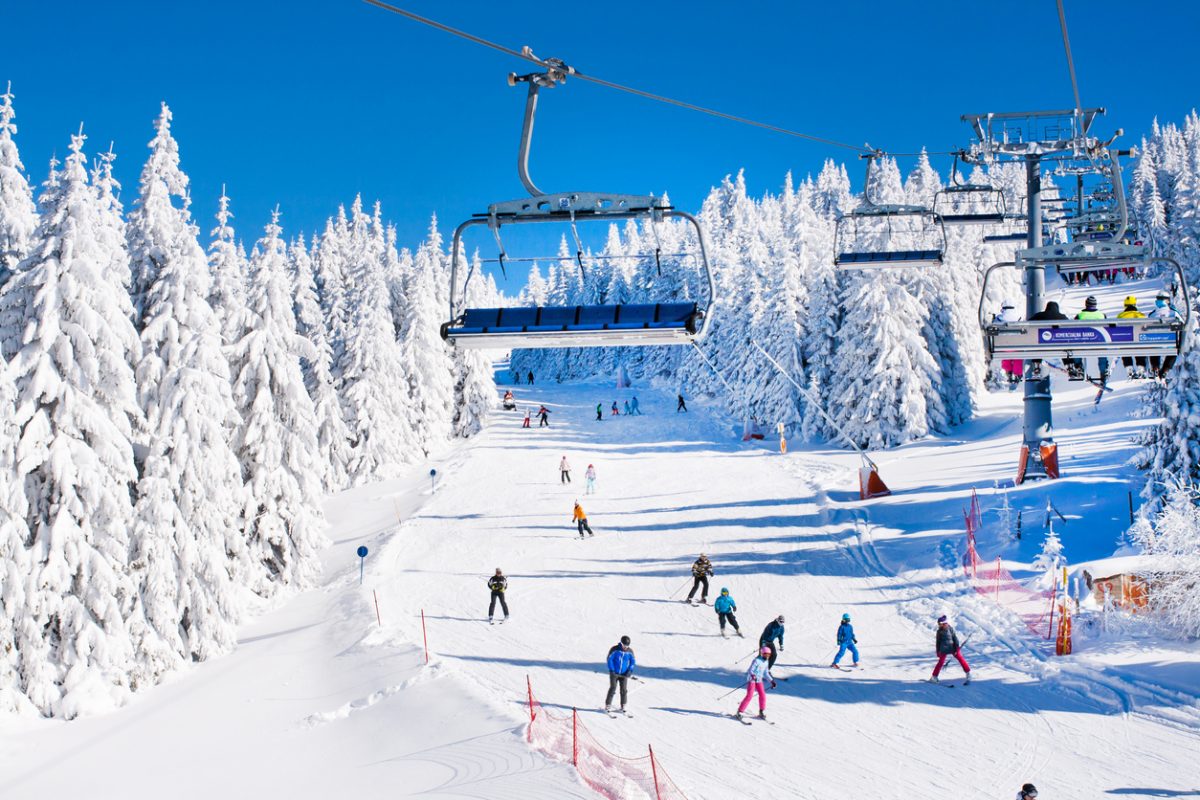
Compared to typical holiday destinations, Serbia may be less popular, but it’s gaining traction with each new season.
The picturesque terrain, monumental buildings, and the natural beauty of the country combine to create a perfect mix for a vacation getaway.
But it’s not just the landscapes that make Serbia appealing; Serbian hospitality adds a unique flavour to the experience.
And if you’re a winter enthusiast, Serbia offers a calm space to pursue your passion, away from the crowds.
Whether it’s skiing, snowboarding, or simply enjoying the crisp winter air, Serbia provides an alternative ski destination that might just surprise you.
Pros and Cons of Skiing in Serbia
| Pros | Cons |
|---|---|
| Several resorts to choose from, including Kopaonik and Stara Planina | Limited options for extreme skiing |
| Affordable ski packages and accommodations | May not match the infrastructure of top European resorts |
| Varied terrain suitable for different skill levels | Seasonal availability can be inconsistent |
| Rich cultural experiences and local cuisine to enjoy | Some areas may lack English-speaking instructors |
| Natural beauty with mountain landscapes | Limited transportation options to more remote resorts |
| Family-friendly options available | Some modern amenities might be lacking in smaller resorts |
Kopaonik

Kopaonik stands out for its variety.
With 60 kilometres of slopes featuring various levels of difficulty, from blue to black, there’s something for everyone.
Whether you’re a beginner or an advanced skier or snowboarder, you’ll find the right piece of slope for yourself.
25 lifts transport thousands of winter enthusiasts daily, satisfying those hungry for beautiful views and the unique allure of the Serbian winter.
Located at an altitude of 2,000 metres above sea level, Kopaonik ensures there’s no need to worry about a lack of snow in the winter.
Babin Zub
Babin Zub, one of the highest peaks on Stara Planina, stands tall at an elevation of almost 1,800 metres in Southern Serbia.
This peak is located to the southeast of Midzor, the highest peak of Stara Planina and Serbia.
For those interested in skiing and snowboarding, Babin Zub offers 13 kilometres of slopes.
With six lifts to transport guests, getting around is convenient.
Skiing in Bosnia and Herzegovina
Bosnia and Herzegovina may be considered one of Europe’s best-kept winter secrets.
Instead of the bustling crowds of traditional winter destinations, you’ll find serene landscapes and untouched beauty here.
Whether you choose the Olympic destinations of the capital, the southern ski resorts near Mostar, or the more remote slopes around Banja Luka, you’re in for an unforgettable experience.
This region offers a snow-covered wonderland that’s not only visually stunning but also budget-friendly.
It’s a unique option for those looking to explore a less travelled path and enjoy the tranquil allure of winter in the Balkans.
Pros and Cons of Skiing in Bosnia
| Pros | Cons |
|---|---|
| Beautiful mountain landscapes, including Jahorina and Bjelašnica | Limited ski resorts compared to other European destinations |
| Affordable options for ski passes and accommodations | Fewer options for advanced skiers |
| Rich historical and cultural experiences nearby | Some areas may lack modern amenities |
| Emerging as a less crowded destination | Inconsistent maintenance of ski facilities |
| Winter festivals and local culinary experiences to explore | Limited transportation options to remote resorts |
Best ski resorts in Bosnia and Herzegovina
Jahorina
The largest ski resort of Bosnia and Herzegovina features Ogorjelica Peak, which stands at 1,916 metres above sea level.
This peak slightly stands out above the surrounding smaller peaks, between which the ski runs wind.
Here, you can find both gentle routes and those with steep slopes, including those on which Olympic competitions were held.
Two completely new six-seat chairlifts and two new ski lifts round out the resort’s offerings.
This ski center boasts a total of 24 ski slopes that stretch 47 kilometres in length, along with 10 kilometres of tracks for Nordic skiing.
The diverse range of slopes and modern facilities make this resort an appealing destination for skiers of all skill levels.
Babin Do – Bjelašnica
Bjelasnica is the name of the summit towering over 2,000 metres above sea level, on the slopes of which a ski resort is nestled.
At its foot lies the Babin Do resort, a growing hub that features an expanding hotel infrastructure, along with numerous restaurants and equipment rentals.
The ski runs, offering various difficulty levels, span approximately 10 kilometres in total.
This ski resort features eight ski trails and five children’s trails.
With its family-friendly options and an array of amenities, this resort is an attractive destination for skiers looking to enjoy both the slopes and the surrounding local attractions.
Skiing in Sweden
Sweden, shaped by numerous ice ages and adorned with unique lakes, is a paradise for winter sports enthusiasts.
Known for its love of saunas and beautiful natural landscapes, Sweden offers excellent conditions for fans of classic winter sports such as cross-country skiing.
The mountain range, stretching along the Norwegian border from the south to the northern part of Sweden, provides a breathtaking backdrop and a multitude of opportunities for winter activities.
Whether you’re seeking the thrill of a downhill run or the serenity of a cross-country trail, Sweden’s winter landscape invites you to embrace the season in all its glory.
Pros and Cons of Skiing in Sweden
| Pros | Cons |
|---|---|
| World-renowned resorts like Åre and Sälen | Higher costs compared to Eastern European destinations |
| Long ski season with reliable snowfall | Less variety for beginner skiers in some areas |
| Excellent facilities and modern amenities | Booking during peak season may be challenging |
| Variety of terrains, including off-piste opportunities | Limited daylight hours in the deep winter |
| Opportunities for other winter activities like dog sledding | Can be crowded during Swedish school vacation periods |
Best ski resorts in Sweden
Åre
The Åre region, known as the winter metropolis of northern Europe, is a haven for skiers and snowboarders alike.
With 107 ski slopes, a winter cross-track, and a fun park for snowboarders, Åre offers a plethora of winter activities.
Located in the central part of Sweden, it stands as one of the largest resorts in Scandinavia and the most modern ski resort in Sweden.
With five ski areas, 40 lifts, and 97 slopes, the range of options is vast and caters to all skill levels.
The skiing around the village of Åre is world-famous, and the slopes are recognizable from the most important World Cup competitions.
Sälen
Sälen is an impressive destination for skiing enthusiasts.
Home to multiple ski areas, it’s a haven for both beginners and seasoned skiers.
You’ll find over 100 slopes, ranging from gentle green runs for those just starting out to challenging black runs for the experts.
The convenience of modern ski lifts makes navigation a breeze, and the well-maintained pistes ensure a smooth ride down.
The region is dotted with inviting cabins and resorts, offering a cozy retreat after a day on the snow.
With opportunities for cross-country skiing and snowboarding, it’s a versatile destination that accommodates various winter sports preferences.
Whether you’re seeking a family-friendly skiing experience or an adrenaline-filled adventure, Sälen’s well-designed ski facilities, beautiful landscapes, and friendly atmosphere make it an appealing choice for your next winter getaway in Sweden.
Skiing in Norway

Norway, with its mountainous landscape, is a sought-after destination for skiing, especially in Scandinavian countries.
The quantity and quality of snow present in Norway make it an ideal place for skiing, attracting both locals and tourists alike.
Ski runs in Norway are varied, catering to all levels of expertise, and the ski resorts maintain a high standard.
Good catering facilities and excellent infrastructure further enhance the skiing experience, making it a well-rounded winter vacation option.
With many modern resorts scattered across the country, the largest ones, boasting around 50 kilometres of ski runs, are located in the south-central part of Norway.
If you’re looking for an exhilarating skiing experience with all the amenities and beautiful natural surroundings, Norway might be the perfect choice for your next winter adventure.
Pros and Cons of Skiing in Norway
| Pros | Cons |
|---|---|
| Stunning natural scenery including fjords | Higher travel and accommodation costs |
| Long ski season extending into May | Some remote resorts may have limited amenities |
| Variety of ski resorts catering to all levels | Weather can be unpredictable |
| Family-friendly options and ski schools | Transportation to remote areas can be challenging |
| Cross-country skiing trails widely available | Shorter daylight hours during winter |
Best ski resorts in Norway
Skimore Oslo
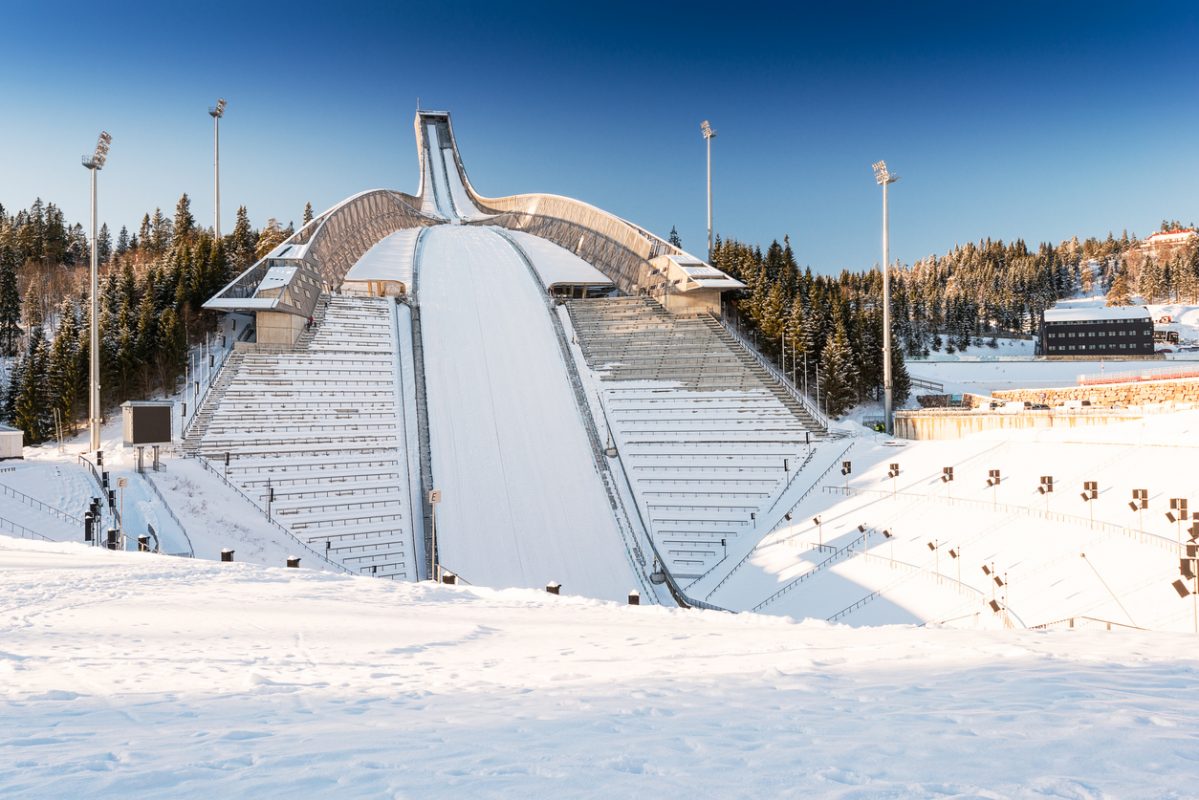
Skimore Oslo is a modern ski resort located in the capital of Norway, just a short distance from the city center.
With 18 well-prepared ski slopes and 11 ski lifts, including three chairlifts, it offers plenty of options for skiing enthusiasts.
You can practice alpine and telemark skiing here, perfect your moves on a snowboard, or simply relax and admire the view of the surrounding area with a cup of hot chocolate.
Its close proximity to the city center makes it a convenient choice for both locals and tourists, allowing for a quick escape to the slopes without the need to travel far.
Trysil
Taking its name from the Trysilfjellet Mountain which it is built around, Trysil ski resort is located in the Buskerud region, on the border with Sweden, and it is a very popular Norwegian resort.
The station offers 71 kilometres of groomed runs, with 33 kilometres of blue runs, 18 kilometres of red runs, and 20 kilometres of black runs, catering to skiers of various skill levels.
The ski lifts take skiers up to a height of 1,100 metres, and the maximum height difference is 635 metres.
From the top, there is a beautiful view of the whole area, providing scenery that’s completely different from the Alps.
Voss
Voss is a charming ski resort located in the heart of the fjord country in Western Norway, not too far from Bergen.
It offers a variety of skiing opportunities across two ski centres, Voss Resort and Voss Fjellandsby Myrkdalen, catering to skiers of all skill levels.
The Voss Resort is one of the largest ski areas in the country, offering 40 kilometres of well-prepared slopes and 12 lifts, including a gondola which takes you right from the town centre to the ski resort.
Voss Fjellandsby Myrkdalen is well-known for being one of the most snow-sure resorts in Norway, offering 22 slopes and 9 lifts.
The area around Voss also provides excellent opportunities for cross-country skiing, with more than 70 kilometres of trails available.
The combination of alpine skiing, picturesque landscapes, and the unique opportunity to combine skiing with fjord excursions make Voss a standout destination for winter enthusiasts.
With its rich cultural heritage and various other outdoor activities available, Voss is not just a destination for skiing but a wholesome experience for those looking to explore the authentic Norwegian winter.
Lyngen

Lyngen, near Tromsø in Northern Norway, is a distinctive and appealing destination for winter sports enthusiasts, particularly those interested in more adventurous pursuits.
This area is famous for its Lyngen Alps, a majestic mountain range that stretches 90 kilometres along the Lyngen Peninsula. These mountains rise sharply from the sea to peaks of over 1,500 metres.
Lyngen is not a conventional ski resort with groomed slopes and lifts; instead, it offers a paradise for backcountry ski touring.
The terrain is varied and can cater to a range of skill levels, but it’s particularly appealing to those looking for challenging descents.
The area’s reputation for deep snow and steep terrain has made it a magnet for extreme skiers. Guided tours are available for those new to the area or looking for an introduction to backcountry skiing.
In addition to skiing, the location provides opportunities to experience the Northern Lights, as Tromsø is one of the best places on earth to witness this breathtaking natural phenomenon.
Skiing in Finland

Are you looking for an exceptional winter experience? Finland may be your ideal destination.
Though Finland doesn’t boast towering peaks, its ski slopes are diverse and well-maintained, offering you an unforgettable experience.
If you’re an adrenaline-seeker who loves white powder and isn’t daunted by low temperatures, Finland’s exhilarating downhill runs and tranquil cross-country trails await you.
You might be wondering about the snow conditions in Finland. Rest assured, the country’s northerly location ensures excellent conditions, with low temperatures keeping the snow crisp and fresh.
But skiing isn’t the only winter attraction in Finland. Have you ever witnessed the mesmerizing Northern Lights? Here, you have a chance to experience this magical phenomenon.
After a day on the slopes, why not indulge in a traditional sauna? Finnish hospitality is known to be warm and welcoming, perfect for relaxing after an adventurous day.
And if you’re travelling with family, a visit to Santa Claus’s home in Lapland could add a sprinkle of magic to your trip.
Pros and Cons of Skiing in Finland
| Pros | Cons |
|---|---|
| Numerous resorts like Levi and Ruka | Short vertical drops, limiting challenges for experts |
| Excellent opportunities for cross-country skiing | Higher costs for accommodations and passes |
| Long ski season with consistent snowfall | Limited après-ski options in some areas |
| Northern location offers a chance to see the Northern Lights | Travel to remote resorts may require planning |
| Family-friendly activities including Santa Claus Village | Rental equipment may be more expensive |
Best ski resorts in Finland
Ylläs
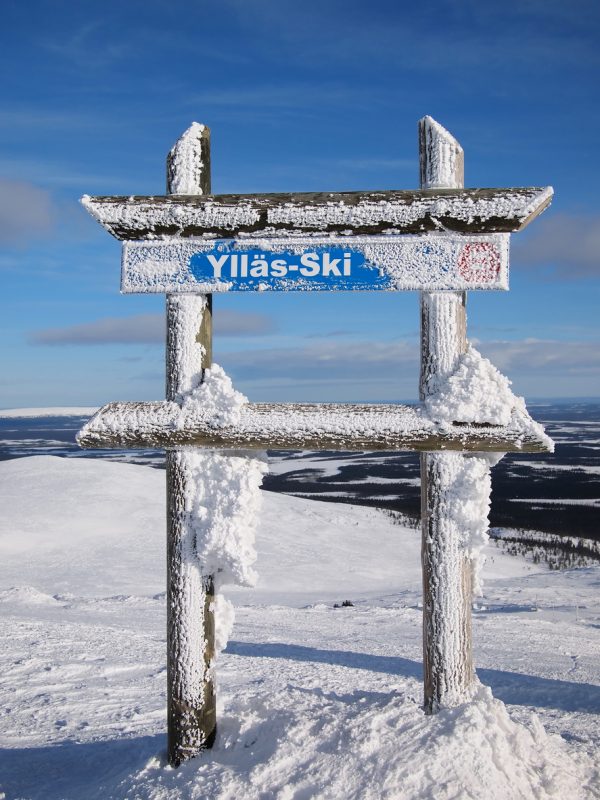
Are you an avid skier looking for a destination with stable snow cover, spacious slopes, and a lack of crowds? Ylläs Resort in Finland might be the perfect place for you to dedicate your time to the slopes.
One thing that sets Ylläs apart is that it boasts the longest ski run in Finland, an exhilarating stretch of three thousand metres.
In true Finnish style, Ylläs is home to the only gondola sauna in the world, located right inside a lift cabin.
Imagine relaxing in a sauna while taking in the snow-covered landscape from above. It’s a unique experience you won’t find anywhere else!
Skiing in Iceland
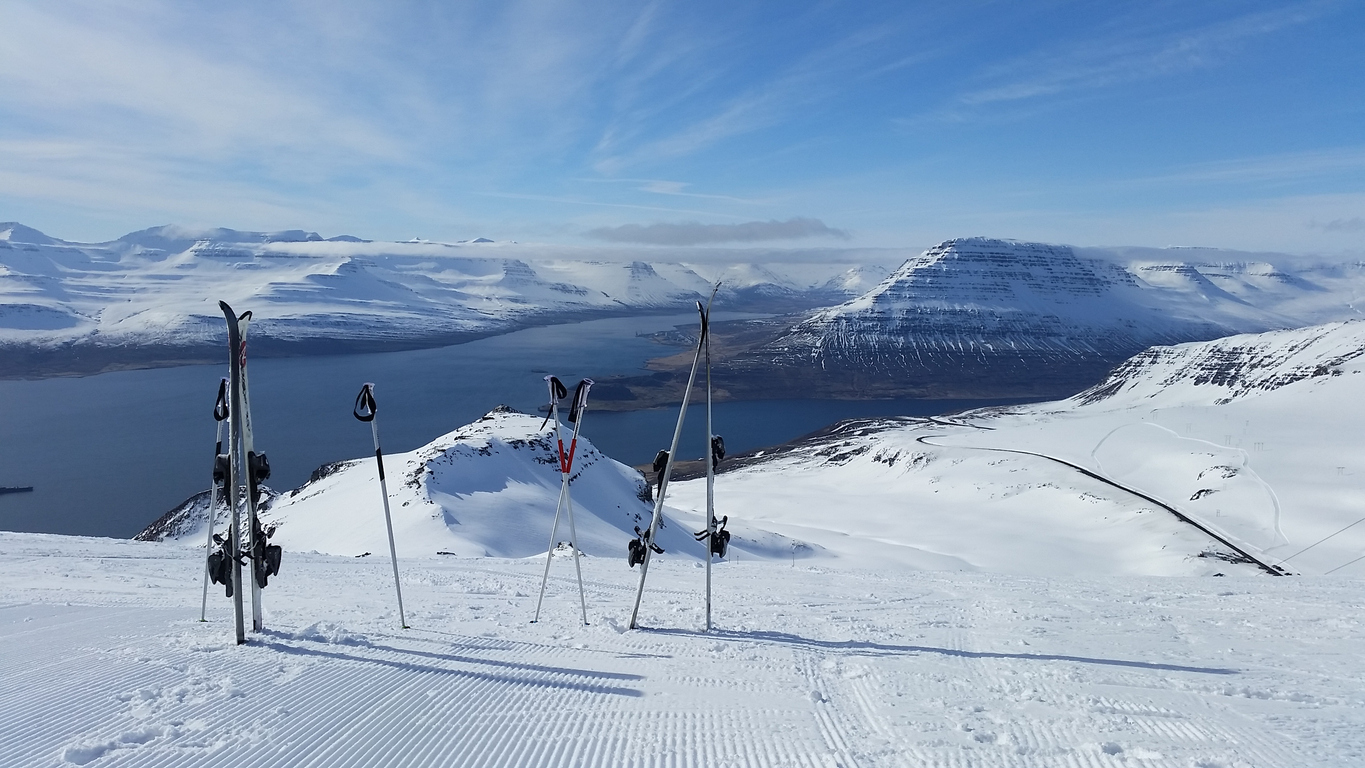
Are you a ski enthusiast on the hunt for a one-of-a-kind ski holiday? Look no further than Iceland, a small island country packed with big winter thrills.
Imagine yourself gliding down seventy-five kilometres of pistes spread across eleven different ski areas. Whether you’re an expert or a beginner, you’ll find a variety of slopes to match your skills.
But what really sets Iceland apart for a winter holiday? The aurora, of course!
Can you picture yourself at the end of an exhilarating day on the slopes, looking up at the night sky to witness the magical dance of the Northern Lights?
This breathtaking natural phenomenon can make your trip truly unforgettable.
Pros and Cons of Skiing in Iceland
| Pros | Cons |
|---|---|
| Unique skiing experience under the Northern Lights | Limited number of ski resorts |
| Geothermal hot springs available for relaxation | Short ski seasons, depending on weather |
| Offers a blend of alpine and cross-country skiing | Limited options for advanced skiers |
| Less crowded compared to major European ski destinations | Higher costs for travel and accommodation |
| Opportunities for heli-skiing and off-piste adventures | Accessibility to remote areas may be challenging |
| Close proximity to Reykjavik for some ski areas | Inconsistent snow conditions in certain regions |
Best ski resorts in Iceland
Hlíðarfjall
Are you considering a skiing adventure near the charming town of Akureyri, Iceland?
Just five kilometres away, you’ll find Hliðarfjall, a unique destination considered to be the best-lifted ski area in the country.
Imagine yourself exploring twenty-six marked pistes, all equipped with seven ski lifts. Whether you’re a seasoned pro or just starting out, you’ll find runs that fit your skill level, all waiting for you in this stunning location.
And what about skiing during the shortest days of the year? Don’t worry! Hliðarfjall has you covered with special lights that make skiing in the middle of the night an exciting possibility.
Picture yourself gliding down the slopes under a starlit sky, with the mesmerizing Icelandic landscape as your backdrop.
Best party ski resorts in Europe

Looking for the ultimate winter thrill? Dive into the vibrant atmosphere of the best party ski resorts in Europe, where the excitement on the slopes is matched only by the exhilaration of the nightlife.
Ischgl, Austria, known for having some of the best après ski in Europe, lures adventurers with its thrilling slopes and dance floors that come alive at night.
Meanwhile, Val Thorens in France, not only offers exceptional skiing but a sizzling party scene that’s known to attract top DJs from around the globe.
The best party ski resorts in Europe wouldn’t be complete without mentioning St. Anton, Austria.
This place is a social hub where the bars and nightclubs resonate with energy and camaraderie.
Best off-piste skiing in Europe
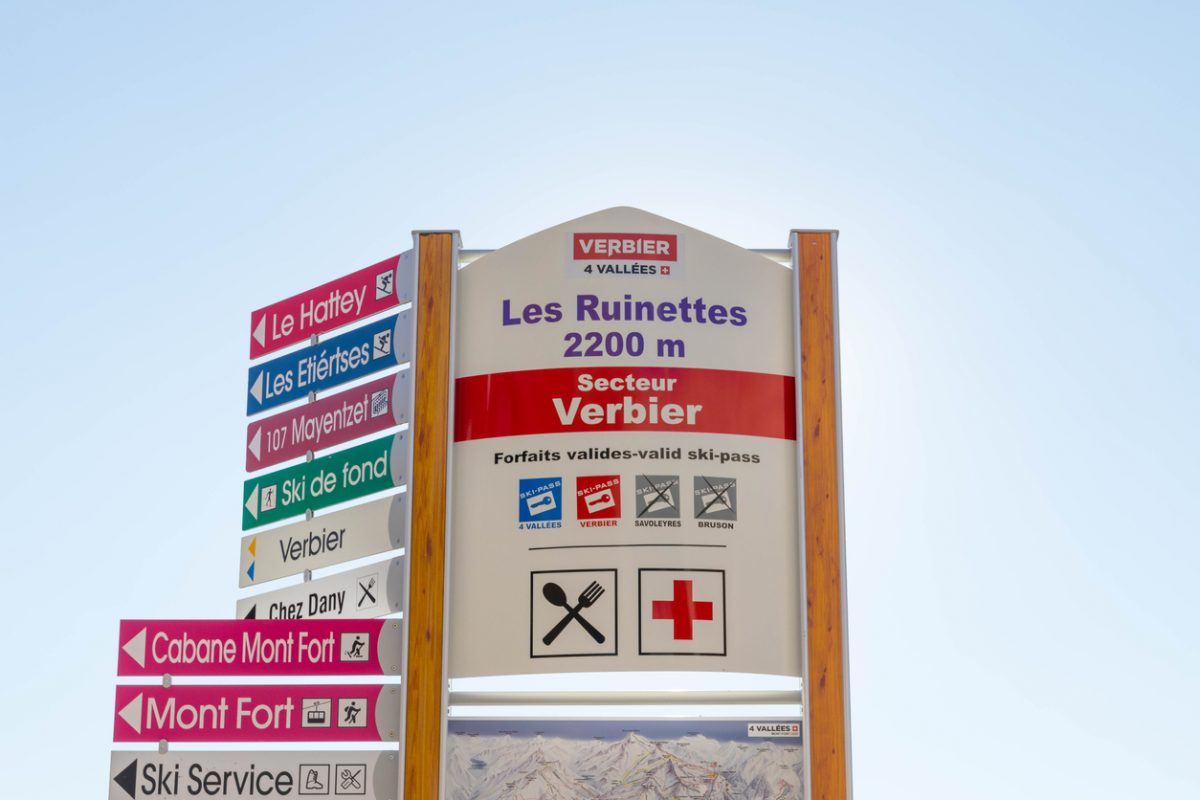
Craving the ultimate skiing adventure that takes you beyond the traditional slopes? Set your sights on the best off-piste skiing in Europe, where untouched snow, thrilling descents, and breathtaking landscapes await those bold enough to venture off the beaten track.
In the heart of the French Alps, Chamonix presents a paradise for off-piste enthusiasts.
Known as the freeride capital of Europe, Chamonix’s towering peaks and deep valleys offer endless opportunities for off-piste skiing.
Austria’s St. Anton isn’t just famous for its party scene; it’s also home to some of the best off-piste skiing in Europe. Challenge yourself on the Valluga Face or embrace the untouched beauty of the Schindler Spitze.
Venture to Verbier in Switzerland, where world-renowned freeride zones such as Mont Fort and Bec des Rosses promise thrilling rides for those willing to take the plunge.
Or, experience the wild charm of Italy’s Courmayeur, where spectacular off-piste trails wind through picturesque forests and alpine meadows.
Highest ski resort in Europe
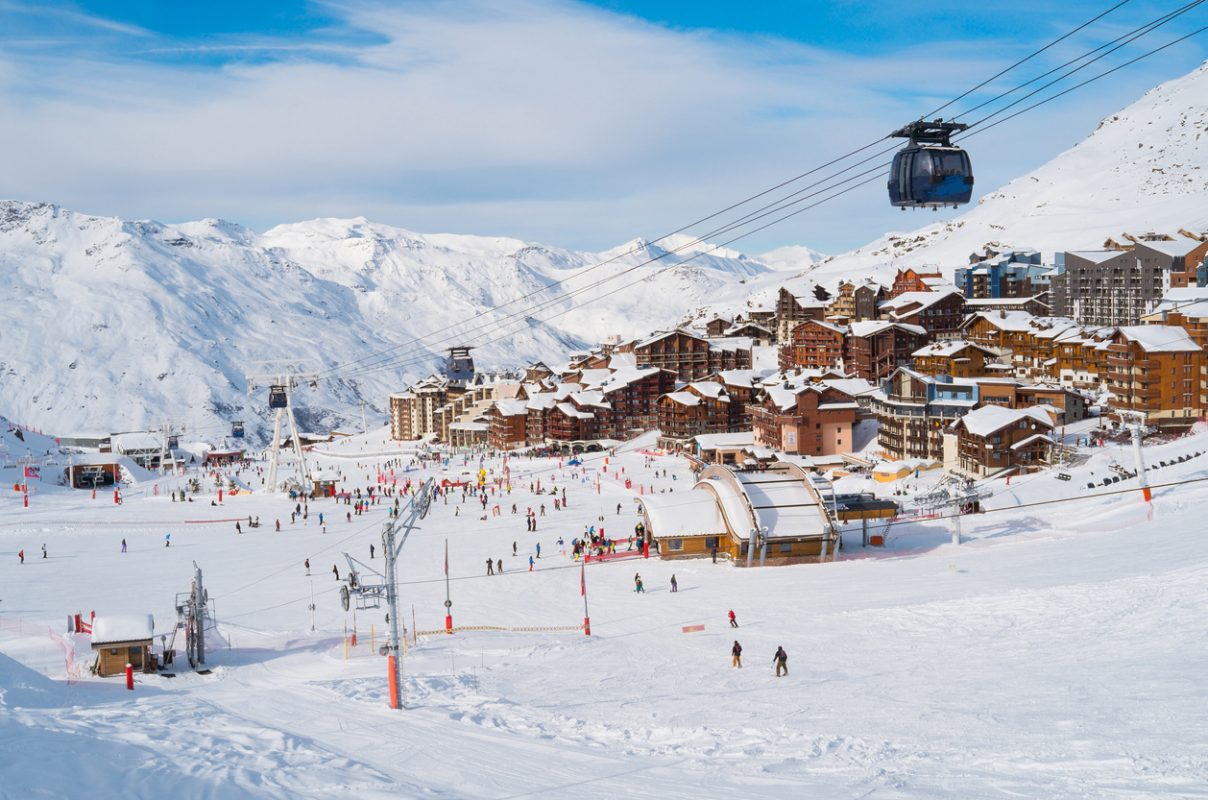
Seeking the pinnacle of European skiing experiences? Aim for the highest ski resort in Europe, where you can ascend to incredible heights and explore terrains that reach closer to the sky than any other.
Val Thorens, located in France’s Three Valleys, holds the prestigious title of the highest ski resort in Europe. Perched at an altitude of 2,300 meters (7,546 feet), it’s a place where the snow is crisp, the views are breathtaking, and the skiing is nothing short of legendary.
The resort’s elevation guarantees an extended ski season, often beginning in November and stretching into May. You’ll find over 600 kilometres (373 miles) of connected trails that cater to all skill levels, from gentle beginner runs to challenging black diamond slopes.
The panoramic views from Europe’s loftiest resort are truly unparalleled, offering a sweeping vista of majestic peaks and sprawling valleys.
Off the slopes, Val Thorens provides a vibrant après-ski scene with an array of bars, restaurants, and entertainment venues.
The resort’s modern infrastructure ensures comfort and convenience, making it an attractive destination for families, couples, and solo adventurers alike.
Best ski resorts for non-skiiers in Europe

Are you drawn to the wintery mountains of Europe, but skiing isn’t your cup of hot cocoa?
Fear not, as Europe boasts some of the best ski resorts for non-skiers, offering an array of activities that go far beyond the slopes.
Chamonix, France, sets the stage for an unforgettable winter holiday for those not strapping on the skis.
In the shadow of Mont Blanc, Chamonix is renowned for its stunning scenery and diverse offerings. From relaxing in luxurious spas to exploring charming villages, this destination caters to all tastes.
St. Moritz in Switzerland is synonymous with elegance and style. Its rich cultural heritage, high-end shopping, and gourmet dining make it a favorite among non-skiers. Don’t miss a romantic horse-drawn carriage ride or a visit to its famous frozen lake, which transforms into a playground for skating, polo, and ice cricket.
Zermatt, Switzerland, is a car-free village that lets you escape into a winter wonderland without ever putting on skis. Wander through its picturesque streets, take a cogwheel train to the Gornergrat to marvel at the Matterhorn, or savour some of the finest Swiss cuisine.
Or, head to Cortina d’Ampezzo, Italy.
With its dramatic Dolomite backdrop, Cortina offers spectacular winter hikes, thrilling ice climbing, and plenty of opportunities to indulge in Italian gastronomy.
Finally, Innsbruck, Austria, known as the “Capital of the Alps,” blends urban sophistication with alpine charm.
Visit its historic old town, catch a performance at the theater, or simply enjoy the festive atmosphere of its Christmas markets.
Best skiing for beginners in Europe
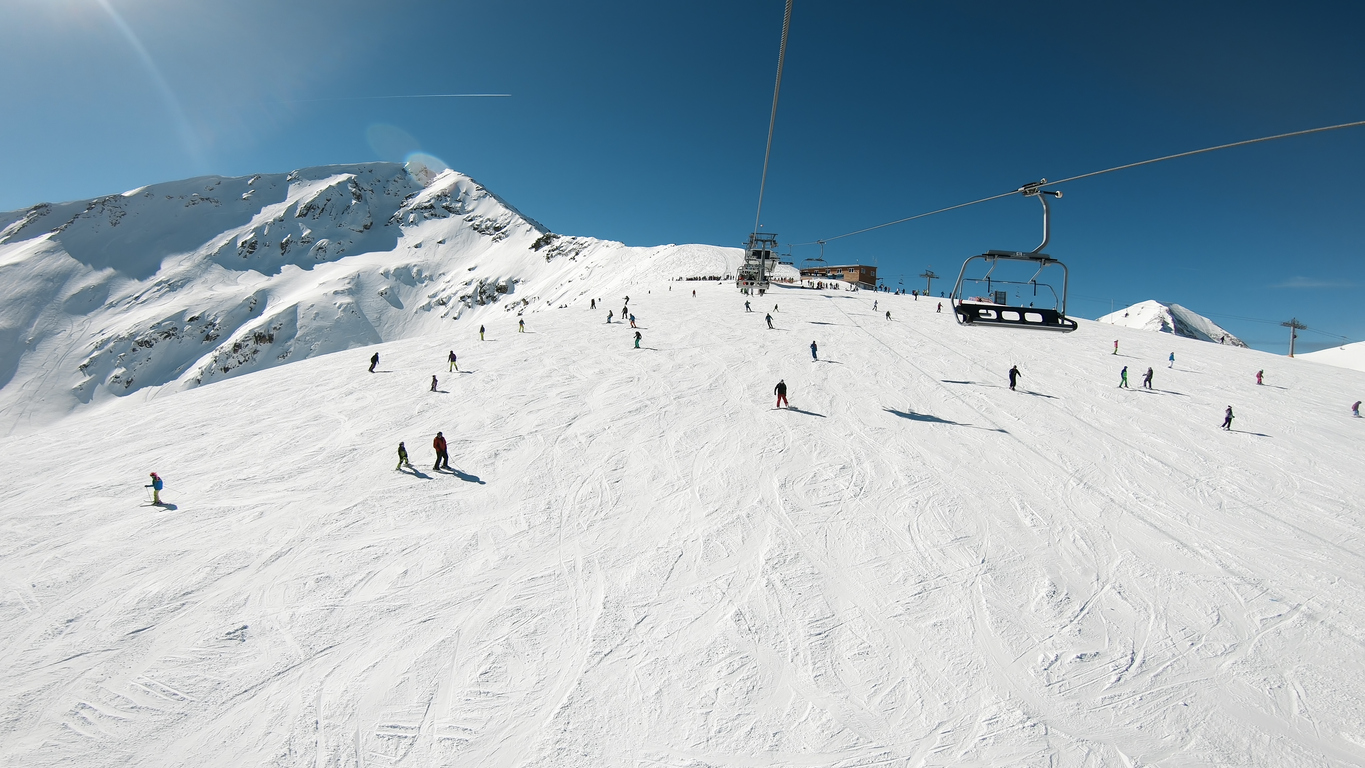
If you’re just starting on your skiing journey and looking to find the perfect place to learn the ropes, Europe offers a plethora of destinations that cater specifically to newcomers.
The beginner ski resorts in Europe provide an ideal setting to take those first strides down the slopes, with gentle terrains, top-notch ski schools, and a welcoming atmosphere.
Val Thorens in France is a popular choice, boasting a variety of wide, forgiving slopes and professional instructors eager to guide you through the basics.
Situated in the world-renowned Three Valleys, this resort offers the beginner-friendly environment needed to boost your confidence on the snow.
In Austria, Alpbach is known as one of the best places for newcomers to skiing. The charm of this small village is matched by its well-groomed beginner slopes and excellent ski schools.
With a family-friendly vibe, it’s an inviting destination for those taking their first skiing steps.
Passo Tonale in Italy stands out for its array of gentle slopes, making it a favorite among novice skiers. Its high-altitude location ensures reliable snow, and the local ski schools are renowned for turning beginners into confident skiers.
La Rosière in France also offers an appealing proposition for beginners, with a mix of sunny slopes and English-speaking instructors.
Heading east? Try Zakopane or Bansko, both of which are large resorts with plenty of facilities.
Best Family Ski Resorts in Europe
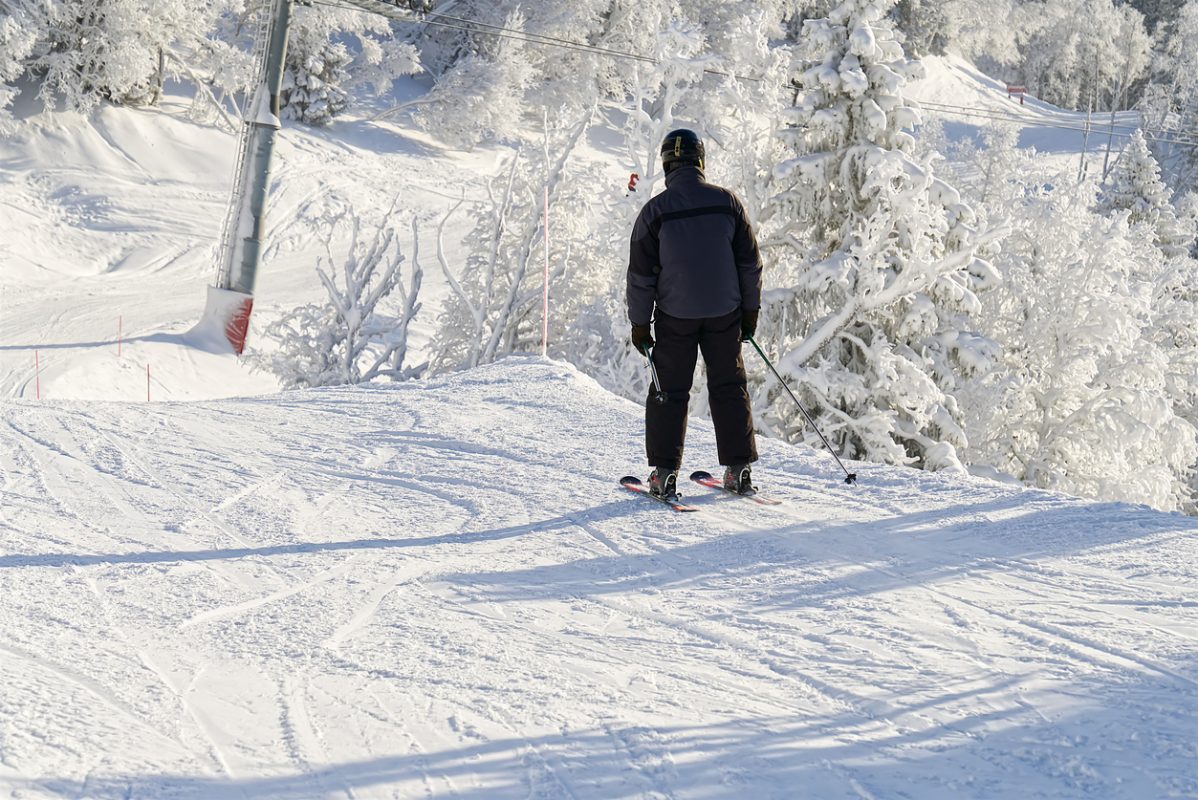
Finding the perfect destination for a family ski holiday can be a challenge, but Europe’s array of family-friendly ski resorts makes the decision-making process a breeze.
The best family ski resorts in Europe offer a balance of fun, safety, convenience, and a range of activities to keep everyone entertained, both on and off the slopes.
France’s Les Gets stands out as a family favorite, offering a dedicated children’s area, beginner-friendly slopes, and a charming village atmosphere. The resort prioritizes family needs, providing childcare services and family entertainment throughout the season.
In Austria, Serfaus-Fiss-Ladis is renowned as one of the top family destinations. With its extensive network of ski schools, children’s play areas, and family-friendly accommodations, it’s a resort designed with kids in mind.
The skiing options cater to all levels, ensuring that everyone in the family, from beginners to advanced skiers, can enjoy their time on the snow.
Avoriaz, located in the French Alps, is another family gem. The car-free village ensures a safe environment for kids to explore, while the Aquariaz water park offers a unique aquatic playground as an alternative to skiing.
With a wide selection of slopes, Avoriaz caters to the entire family’s skiing needs.
Italy’s Val Gardena is not only picturesque but also packed with family-friendly features. Ski schools, nursery slopes, and a host of non-skiing activities make it an all-round family destination. The traditional alpine charm of the village adds to the appeal.
Switzerland’s Grindelwald is another must-visit for families. The stunning scenery is matched by its family-centric services, including child care, beginner slopes, and a variety of winter activities like sledding and ice skating.
FAQs about skiing in Europe
Which country in Europe has the best skiing?
Determining the “best” country for skiing in Europe can vary based on individual preferences, skill levels, and desired experiences.
Austria, France, and Switzerland are often mentioned as top contenders, offering a wide variety of resorts, excellent snow conditions, and vibrant après-ski scenes.
Italy and Norway are also highly regarded for their beautiful landscapes and quality ski facilities.
What 3 countries are ski resorts in Europe?
Ski resorts are widespread throughout Europe, but three of the most renowned countries for skiing are France, Austria, and Switzerland. T
hese countries are home to some of the most famous ski destinations in the world, including Chamonix in France, St. Anton in Austria, and Zermatt in Switzerland.
What time of year is best to ski in Europe?
The best time to ski in Europe typically falls between late November and early April.
December to February offers the most reliable snow conditions, while March and April provide milder weather and longer days but still with good snow coverage in many resorts.
Where has the most snow for skiing in Europe?
Some of the areas with the most consistent and abundant snowfall in Europe include Val d’Isère and Tignes in France, St. Anton in Austria, and Zermatt in Switzerland.
These areas have strong snow records and often benefit from both early and late-season snow.
What is the cheapest month to ski in Europe?
The cheapest month to ski in Europe is often in late November, early December, or late April when the season is just beginning or winding down.
During these times, you might find lower prices on accommodation, lift passes, and flights.
What is the cheapest time of year to ski in Europe?
Similar to the cheapest month, the cheapest time of the year to ski in Europe is generally at the very beginning or very end of the ski season.
Early December and late April are typically more affordable, though snow conditions can be more unpredictable.
What are the most expensive countries to ski in Europe?
Switzerland is often considered the most expensive country to ski in Europe, followed closely by France and Austria.
High costs for accommodation, lift passes, and dining contribute to the elevated expenses in these countries.
What is the most expensive week to go skiing?
The most expensive week to go skiing usually falls during the peak holiday periods such as Christmas, New Year’s, and the school half-term holidays in February.
During these weeks, prices for accommodation, travel, and ski passes can be significantly higher.
What is the best month to ski in Italy?
The best month to ski in Italy generally falls between January and March.
During this time, the snow conditions are usually excellent, and the weather is relatively stable, offering cold temperatures that help preserve the snow quality without being overly harsh.

